Repair guides for German motorcycles BMW K-series
See this section in russian language
This repair manual will help you to perform all the main maintenance and repair work correctly and efficiently for German motorcycles «BMW K1200LT» which were produced from 1998 to 2009.
Description and history of German motorcycles BMW K-series
BMW K75 series (1985-1996)
The BMW K75 series is a line of motorcycles from the brand BMW. The K75 series was produced between 1985 and 1996 and included several models.
In the late 1970s, BMW launched the /7 series. These were the repeatedly upgraded air-cooled two-cylinder boxer engines with shaft drive, which actually stemmed from the engine concept of 1969. However, these boxer engines were nearing the end of their lifecycle. Japanese competition dominated the market, moving towards increasingly powerful and faster motorcycles. Additionally, the Japanese four-cylinder engines ran much smoother than the boxer engines and were also easier to handle. They lacked the "tipping moment" that was typical of the longitudinally mounted crankshaft of the BMWs. Furthermore, European environmental regulations were becoming stricter. Although BMW had increasingly focused on touring motorcycles, the arrival of the Honda GoldWing brought competition equipped with a smoothly running liquid-cooled four-cylinder engine.
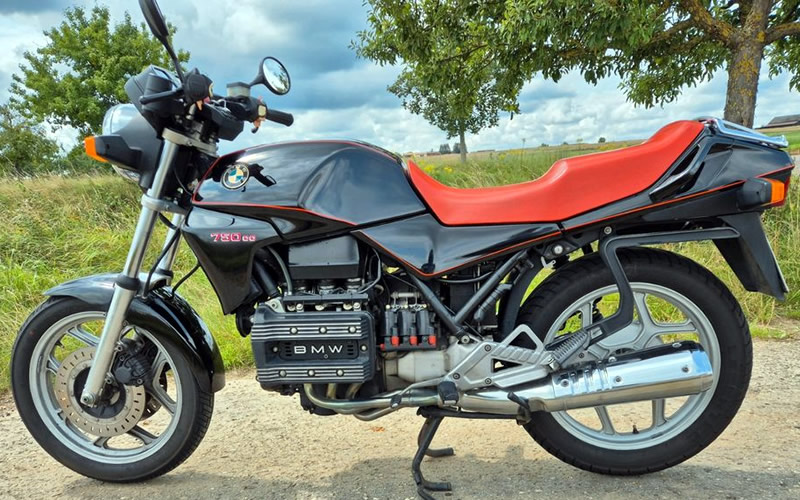
K 75, 1987 year, left view
As early as 1978, the German magazine Motorrad published concept drawings of a four-cylinder BMW boxer engine, mentioning that a longitudinally mounted four-cylinder inline engine or even a three-cylinder inline engine were possibilities. The project was then called "BMW K4". Within the company, the feasibility of a four-cylinder boxer engine was also explored, but BMW wanted to build a distinctive engine. Thus, experiments with a heavy, wide, and high transverse-mounted Peugeot engine were discarded. BMW had already considered alternative engine concepts during the preparations for the R45/R65 series, but at that time, the preservation of the shaft drive was a requirement. This was also the case now. This determined the choice of a longitudinally mounted engine, as it would avoid a 90° angle in the drive line, which would cost a considerable amount of power. The choice thus fell on a longitudinally mounted engine with horizontal cylinders, similar to an underfloor engine. This immediately achieved a low center of gravity. In 1983, the BMW K100 series was launched. For customers who preferred a smaller engine displacement, the R45 and R65 models, now equipped with the monolever single-sided swingarm, remained in production until 1985.
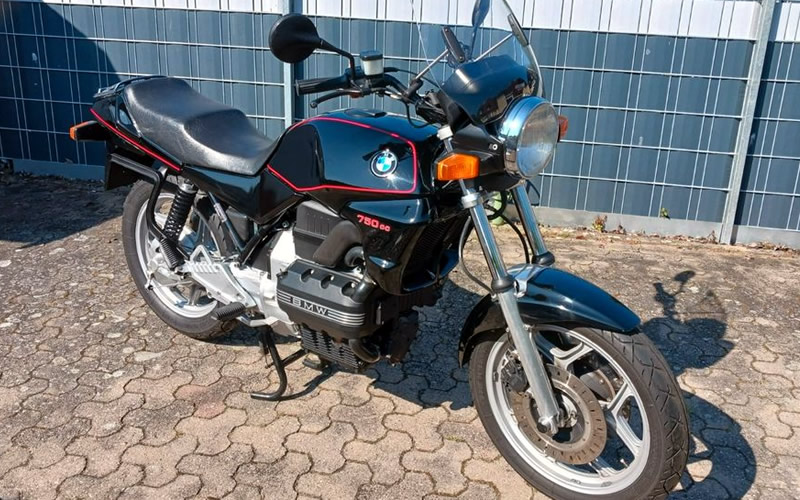
K 75, 1988 year, front view
In 1985, the K75 series was introduced with three models: the "base" K75 naked bike, the K75C, equipped with a small fairing, and the K75S, featuring a top fairing.
The K75 received a liquid-cooled three-cylinder inline engine with horizontal cylinders. Like the K100, it was a long-stroke engine (bore × stroke = 67×70 mm). This allowed BMW to continue applying the modular construction system: the engines had the same pistons and cylinders. The 180° crankshaft of the K100 was, of course, replaced by a 120° version with three crank pins. The crankshaft was located on the right side of the engine, with the cylinders pointing to the left. A crankcase cover was placed on the right side, allowing the entire engine to be disassembled without removing it from the frame. The engine had two valves per cylinder. Fuel injection was used for the first time (Bosch L-Jetronic). The two overhead camshafts were driven by a chain. To counteract the tipping moment, as many components as possible (alternator, clutch, and gearbox) rotated in the opposite direction to the crankshaft. Thanks to an impressive output of 75 hp (the R 80 only reached 50 hp), this motorcycle could easily compete with others.
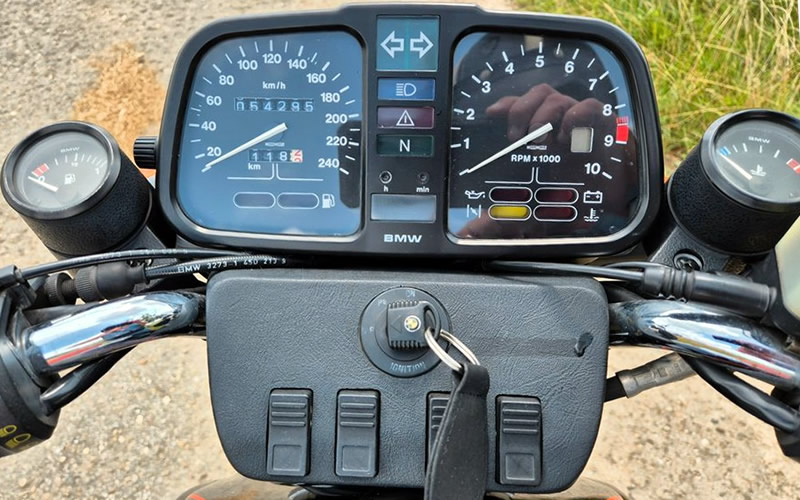
K 75, 1986 year, dashboard
BMW still used the "Baukastensystem" (modular system). The bridge frame developed for the K100, where the engine block served as a load-bearing part, was slightly modified for use in the K75 series. The entire drive train (engine, clutch, gearbox, shaft drive, and rear wheel) was attached to the frame with five bolts. Once these bolts were removed (along with the necessary cables), the rest of the motorcycle could be wheeled away like a wheelbarrow using the front wheel. This principle was not new: the Moto Guzzi V-8 racer from 1955 also featured it. The machine was equipped with the monolever suspension system. Updated cast wheels and brake discs were used. The single dry plate clutch was retained, and the engine had five gears.
The radiator was fitted with a polyester cover in which the recognizable "BMW kidneys" were visible. To emphasize the modern concept, a very noticeable square exhaust silencer was used on the K100, equipped with a black heat shield. On the K75, this was replaced by a triangular version. As was customary at BMW, an excellent set of onboard tools and a first aid kit were provided under the seat. All models were available with a luggage set and, after 1988, also with ABS.
K75
The K75 was a base model. No form of fairing or windscreen was mounted, although the touring windscreen from the K100, which was available as an accessory, also fit this motorcycle due to the identical construction of the K75. The K75 was equipped with disc brakes in the front wheel but had a drum brake in the rear. It was launched in 1986, and a total of 18,485 units were produced until 1996.
K75C
Although the K75C hardly differed from the K75, this motorcycle looked much sportier with its small front fairing. That was the only difference. The K75C was introduced in 1985 and remained in production until 1990, with 9,566 units sold.
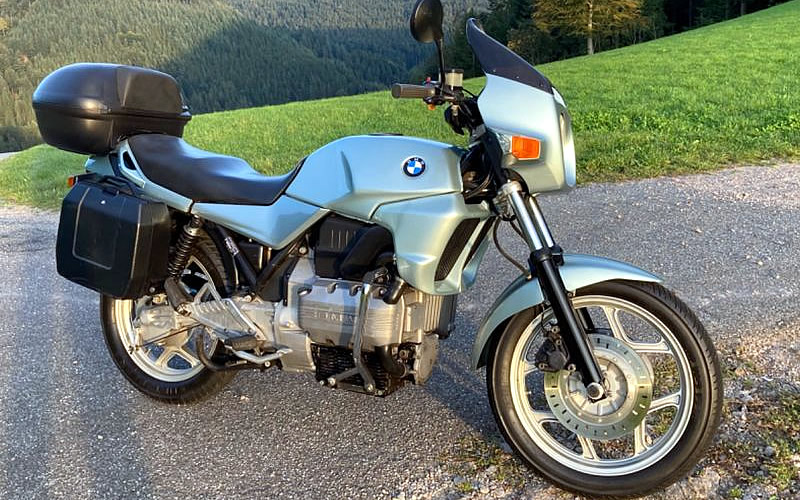
K 75 C, 1985 year, right view
K75S
The K75S was also launched in 1985. This was the sport model of the series, equipped with a top fairing that resembled the streamlined fairing of the "big brother" K100RS. This motorcycle also received two disc brakes in the front, but a disc brake was also applied in the rear to emphasize the sporty character of the motorcycle. However, the engine power was equal to that of the other models in this series. Between 1985 and 1995, 18,649 units were produced. Instead of an 18-inch rear wheel, the K75S was delivered with a 17-inch wheel. Additionally, the handlebars were slightly lower due to the sporty character. The telescopic fork was slightly stiffer sprung for the same reason.

K 75 S, 1989 year, front view
K75T
The K75T was presented in 1986 and disappeared again in 1987. The machine was specifically developed for the American market. Due to the strict requirements of the Environmental Protection Agency, the power was slightly reduced: the machine delivered only 68 hp. To cater to American customers, the comfort seat from the K100LT was sometimes used. Additionally, crash bars were standard. The exact number of K75T units produced is unknown, but they were likely counted among the 9,566 K75C models. It can be stated that it was not a success.
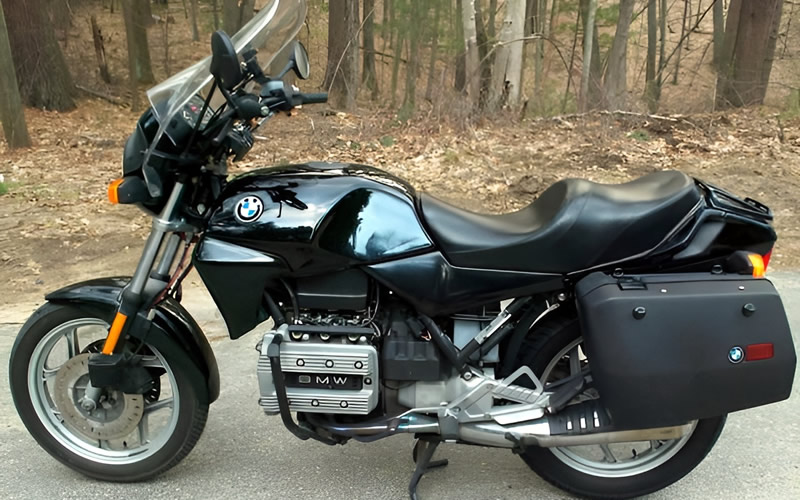
K 75 T, 1986 year, left view
K75RT
The K75RT was produced from 1989 to 1995. It was equipped with the full touring fairing that the K100RT and LT also had. Like the K75S, the telescopic fork was slightly stiffer sprung, but in the case of the RT, this was to accommodate the weight of the fairing. The RT had (again like the "S") a smaller 17" rear wheel. Later versions featured an electrically adjustable windscreen and were available with ABS. The RT was particularly popular among government services. The Royal Marechaussee used the non-ABS version as an escort motorcycle and the version with ABS as a regular "service bike", but of course, the machines were also deployed by German government services.
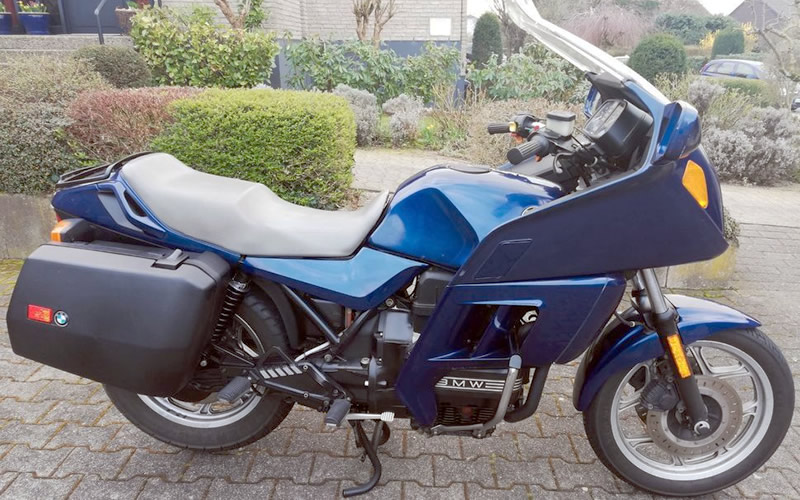
K 75 RT, 1990 year, right view
K75 Ultima and K75RT Ultima
As the name suggests, these models were the last from the K75 series. The Germans themselves referred to them as "Auslaufmodelle" (discontinued models). There were hardly any technical differences from the existing models. The machines received three-spoke cast wheels, the Ultima featured a touring windscreen, and the RT Ultima was delivered in gray/blue with cornflower blue trim. Extra gauges were added to the touring fairing: a fuel gauge on the left and a coolant temperature gauge on the right. The windscreen was infinitely electrically adjustable.
Technical data K75 series
| K75 | K75C | K75S | K75T | K75RT | K75 Ultima | K75RT Ultima | |
| Period | 1985-1996 | 1985-1990 | 1985-1995 | 1986-1987 | 1989-1995 | 1996 | 1996 |
| Production quantity | 18,485 | 9,566 | 18,649 | unknown | 21,264 | unknown | unknown |
| Category | touring motorcycle | touring motorcycle | sports tourer | touring motorcycle | touring motorcycle | touring motorcycle | touring motorcycle |
| Engine type | overhead valve engine | ||||||
| Construction method | longitudinally mounted three-cylinder inline engine | ||||||
| Bore | 67 mm | ||||||
| Stroke | 70 mm | ||||||
| Cylinder capacity | 740 cc | ||||||
| Max. Power | 55 kW/75 hp | 51 kW/68 hp | 55 kW/75 hp | ||||
| Top speed | 200 km/h | 200 km/h | 210 km/h | unknown | 185 km/h | 200 km/h | 185 km/h |
| Drive | cardan shaft | ||||||
| Bicycle part | bridge frame | ||||||
| Empty weight | 227 kg | 227 kg | 229 kg | 227 kg | 258 kg | 227 kg | 258 kg |
| Max. total weight | 450 kg | ||||||
| Tank capacity | 21 liter | ||||||
| Predecessor | no | no | no | no | R80RT | K75 | K75RT |
| Successor | K75 Ultima | no | no | no | K75RT Ultima | no | no |
BMW K100 series (1983-1991)
The BMW K100 was both a new motorcycle series from BMW and the designation for the base model of this series, which was delivered starting in 1983. These motorcycles with inline engines were produced until 1991. The development, based on an idea by Josef Fritzenwenger from 1977, began in 1979.

K 100, 1985 year, left view
The motorcycles of the K series featured, for the first time instead of the typical air-cooled boxer engine from BMW, a longitudinally mounted, water-cooled 2-valve inline four-cylinder engine with two overhead camshafts. The engine displacement was 987 cm³, with a bore of 67 mm and a stroke of 70 mm. The relatively long stroke was intended to ensure good acceleration (maximum torque of 86 Nm at 6000 rpm) but may have also been chosen with a view to a potential future increase in bore size (known as boring). The power output was 66 kW (90 hp) at 8000 rpm with a compression ratio of 10.2:1. The engine was equipped with an electronically controlled Bosch LE-Jetronic fuel injection system. The camshafts are driven by a chain. The water cooler is mounted above the engine and covered with aluminum fairing.

K 100, 1991 year, right view
The engine, five-speed transmission, and rear-wheel drive are connected as a unit and registered as a "Compact Drive System" at the patent office in Berlin. The single-sided rear swingarm with a driveshaft is supported in the transmission housing. The engine block along with the transmission unit serves as a load-bearing element in an open-bottom bridge frame. The rear wheel has a coil spring with an internal shock absorber, while the front wheel is guided by a telescopic fork. The K100 features a hydraulically operated braking system with two discs at the front and one disc at the rear, each with a diameter of 285 mm.
Variants:
- K100 - Basic variant without fairing, produced from September 1983 to 1990
- K100RS - Sporty variant with a small mask or full fairing, produced from 1983 to 1989
- K100RT - Touring variant with a large full fairing and luggage system, produced from 1984 to 1989
- K100LT - Touring variant with a large full fairing and luggage system, produced from 1986 to 1991
The successors to the K100 were models with 4-valve inline four-cylinder engines, featuring only minor visual changes.
In 1985, two years after the first K100 was delivered, the K75 was offered as a smaller variant. This model was powered by a three-cylinder engine. The K75 was produced until 1996, roughly five years longer than the K100.

K 100, 1983 year, dashboard
A nickname for the K100 was "Flying Brick". This term was used for all models of the K series from 1983 to 2009. These BMW motorcycles received this nickname due to the engine's longitudinally mounted inline configuration, tilted 90 degrees to the left in the direction of travel, which resembles a brick in appearance. Sometimes, the "Flying Brick" is somewhat derogatorily referred to as a "Toaster".
BMW K100RS
The BMW K100RS is a touring and sport motorcycle from BMW with a longitudinally mounted inline four-cylinder engine. The abbreviation RS stands for "Reise-Sport" (Touring-Sport) in BMW terminology (first introduced with the R100RS in 1976) and "Road-Sport" internationally.

K 100 RS, 1984 year, left view
As a sport-touring motorcycle, the K100RS is the top model of the K100 series. In addition to the equipment of the base version BMW K100, the RS features an aerodynamically optimized full fairing designed in a wind tunnel, with a low windscreen equipped with a spoiler and side-mounted mirrors with integrated turn signals. The sister model RT, which has the same technical specifications, has a comfort-oriented full fairing with a higher touring screen and a wide handlebar, leading to a lower top speed but allowing for a more relaxed ride.
The K100RS was succeeded in 1989 by the K100RS 4V. Starting in 1988, the RS was available with an anti-lock braking system (ABS) as an option (approximately 10 kg additional weight). Some K100RS models were retrofitted in the USA with performance-enhancing Luftmeister turbochargers; this engine performance enhancement was managed without significant issues by the engine and chassis.
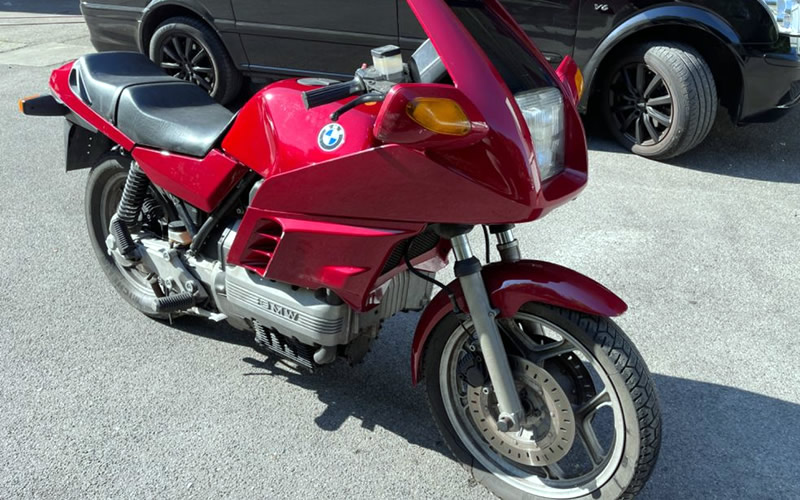
K 100 RS, 1986 year, front view
BMW invested 250 million Deutsche Marks in the modernization of the Berlin production facility from 1980 to 1983, with an additional 200 million Marks until 1986. From 1983 to 1989, the K100RS was produced 34,804 times, and from 1989 to 1992 as the K100RS 4V, 12,666 times at the BMW factory in Spandau, Berlin.
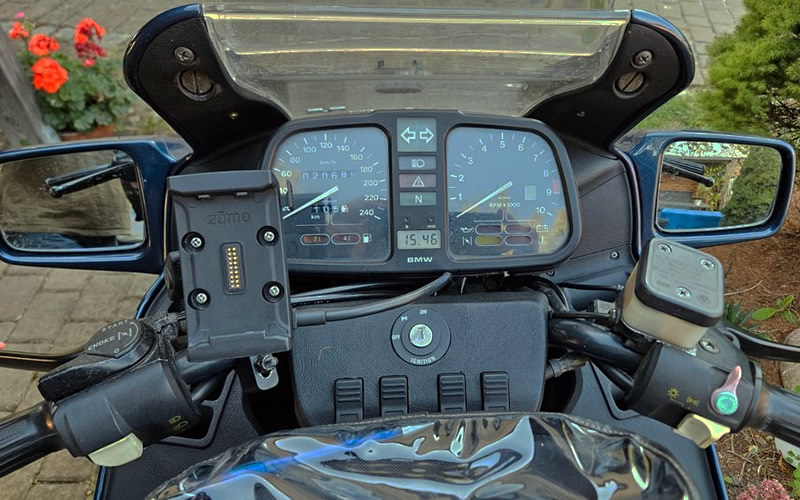
K 100 RS, 1987 year, dashboard
The liquid-cooled four-cylinder four-stroke engine, technically identical across all models of the K100 series, also produces a rated output of 66 kW (90 hp) and a maximum torque of 86 Nm at 6000 rpm from 987 cm³ of displacement in the RS. The four cylinders of the longitudinally mounted inline engine have a bore of 67 mm. The piston stroke is 70 mm, and the compression ratio is 10.2:1. The engine block with the transmission unit is made from a lightweight aluminum alloy and weighs 76.5 kg. An automatic throttle cutoff reduces fuel consumption during coasting up to 2000 rpm. The engine management system limits the ignition timing above 8600 rpm and cuts off fuel injection above 8750 rpm to prevent engine damage from over-revving.
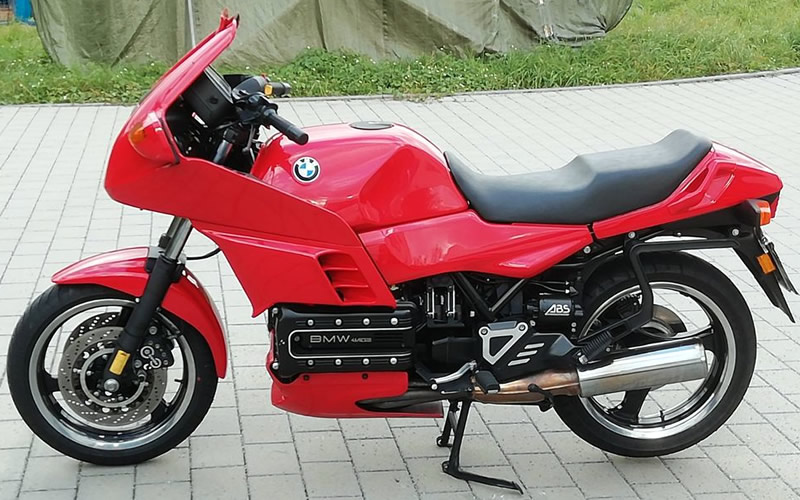
K 100 RS 16V, 1992 year, left view
The motorcycle accelerates from 0 to 100 km/h in 4.3 seconds and achieves a top speed of 221 km/h. The braking distance from 100 km/h to a standstill is 46.5 m, with an average deceleration of 8.3 m/s². The specific power-to-weight ratio is 3.77 kg/kW.
BMW K100RT
The BMW K100RT is a touring motorcycle from the BMW brand featuring a four-cylinder inline engine.
The K100RT is the touring motorcycle of the K100 series, produced 22,335 times at the BMW factory in Spandau, Berlin, from 1984 to 1989. RT stands for Road-Tourer internationally. In addition to the equipment of the base model BMW K100, the RT has a large, wind-resistant fairing optimized for touring to achieve an upright riding position, standard side-mounted BMW luggage system in vehicle color, and radio preparation. The K100LT (Luxury Tourer) was additionally equipped with a top case and the BOGE Nivomat system, a pressure-controlled shock absorber that automatically ensured consistent ground clearance despite varying loads from passengers and luggage. However, the system did not perform well technically; replacement dampers are no longer available today.
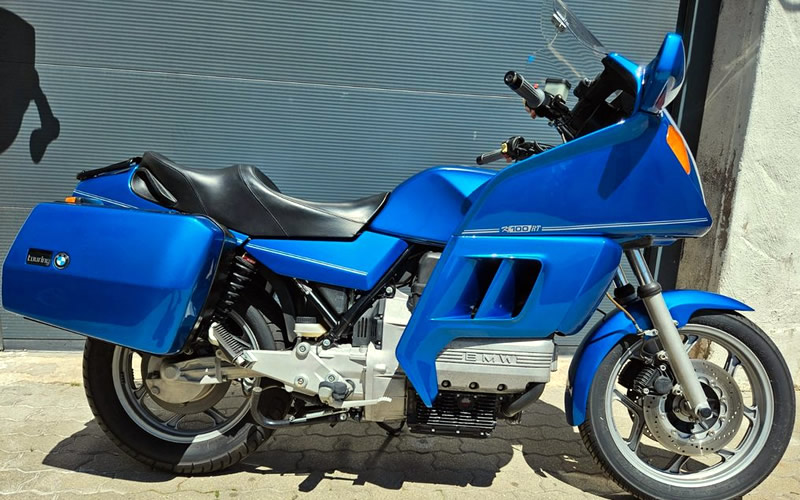
K 100 RT, 1984 year, right view
The early models featured a more inclined windscreen closer to the rider, with a spoiler-reinforced upper edge. The separately mounted spoiler was intended, like on the K100RS, to optimize airflow so that the incoming wind would be directed over the rider's helmet without creating loud turbulence around the helmet area. Starting in 1986, this initial windscreen was replaced due to material weakness with vertical and adjustable inclination screens, which were mounted on the unchanged fairing base until the end of production. The RT was ultimately replaced by the K100LT in 1989, while the BMW K100LT was offered in parallel with the RT since 1986. From 1988, the RT was optionally available with an anti-lock braking system (ABS) for an additional cost (in 1988: 1,980 DM; 10 kg extra weight).
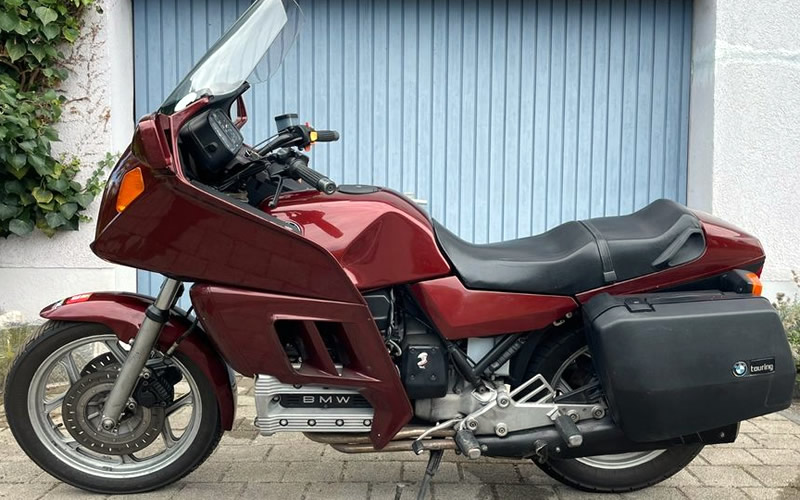
K 100 RT, 1988 year, left view
The vehicle is powered by a liquid-cooled inline four-cylinder engine with two overhead camshafts, wet sump lubrication, and LE-Jetronic fuel injection, which is technically identical across all models of the K100 series. It produces a rated power output of 66 kW (90 hp) from 987 cm³ of displacement at 8000 rpm and delivers a maximum torque of 86 Nm at 6000 rpm. The bore is 67 mm, and the stroke is 70 mm, with a compression ratio of 10.2:1. The engine block with the transmission unit is made from a lightweight aluminum alloy and weighs 76.5 kg.
The motorcycle accelerates from 0 to 100 km/h in 4.5 seconds and reaches a top speed of 206 km/h.

K 100 RT, 1987 year, dashboard
It features a frame with a supporting engine; at the front, there is a telescopic fork with hydraulic shock absorbers providing 185 mm of travel, and at the rear, a BMW Monolever single-sided swingarm with 110 mm of travel. It has lightweight aluminum cast wheels, with a front rim size of 2.50×18 and a rear size of 2.75×17. The front brakes consist of two disc brakes, Ø285 mm, while the rear has a single disc brake, Ø285 mm.
The motorcycle weighs 253 kg when fully fueled and ready to ride, with a permissible total weight of 480 kg. The fuel tank has a capacity of 22 liters.
BMW K100LT
The BMW K100LT is a motorcycle manufactured by BMW. The tourer from the K100 series was produced from 1986 to 1991 at the BMW factory in Spandau, Berlin.
During its five-year production run, 14,899 units of the K100LT (Luxury Tourer) were built. In addition to the equipment of the K100RT (large fairing and luggage system), the LT was equipped with a comfort seat, a top case, and luggage lids painted in vehicle color.
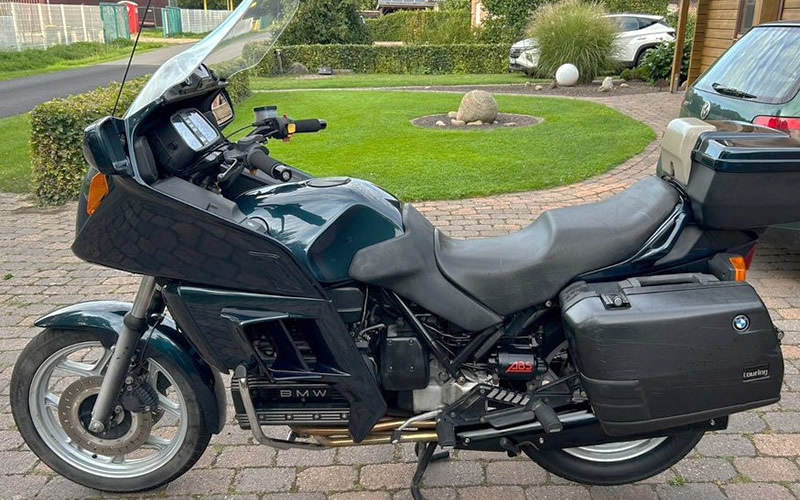
K 100 LT, 1989 year, left view
The LT was initially produced in parallel with the RT but replaced it in 1989. Its successor model was the K1100LT, introduced in 1991.
The K100LT is powered by a water-cooled four-cylinder engine with a displacement of 987 cm³, producing a rated power output of 66 kW (90 hp) and a maximum torque of 86 Nm at 6000 rpm. The inline engine is mounted longitudinally, with a bore of 67 mm and a stroke of 70 mm. The compression ratio is 10.2:1.
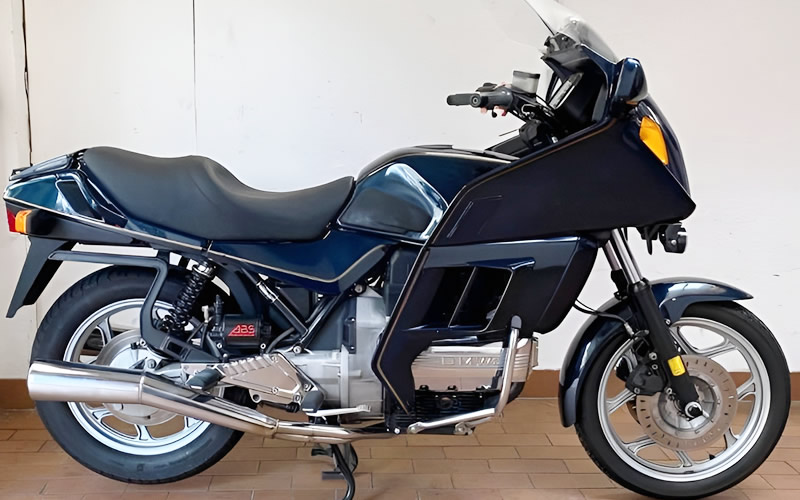
K 100 LT, 1990 year, right view
It features a four-stroke engine with electronically controlled multi-point fuel injection from Bosch (LE-Jetronic) and electronic ignition control. Wet sump lubrication ensures oil supply. The starter battery has a voltage of 12 volts and a capacity of 25 Ah. The alternator generates an electrical output of 460 watts.
The K100LT has a single dry clutch and a claw-shifted five-speed transmission. The torque is transmitted to the rear wheel via a driveshaft.
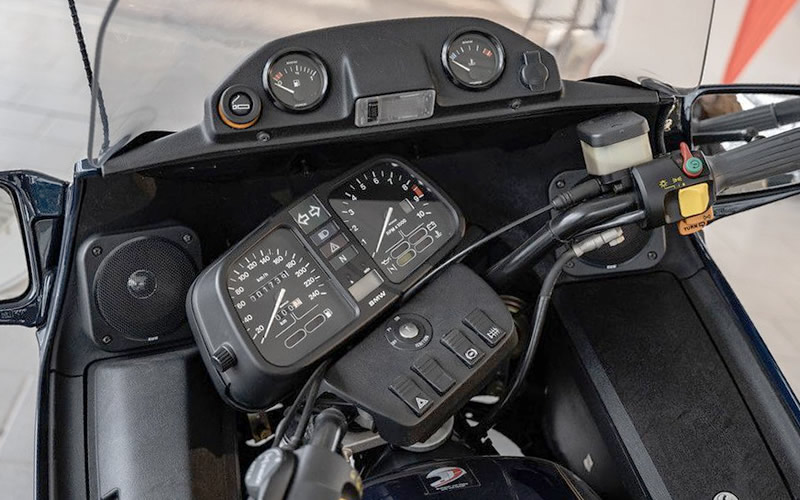
K 100 LT, 1991 year, dashboard
The chassis consists of a bridge frame, a Monolever single-sided swingarm with 110 mm of rear travel, and a telescopic fork with a 41.3 mm stanchion diameter and hydraulic shock absorbers. The braking system features two disc brakes at the front and one at the rear, each with a diameter of 285 mm. From 1988, an anti-lock braking system was available as an option for an additional cost of 1,980 DM, adding 10 kg to the weight.
The cast wheels are made of lightweight aluminum, with a front rim size of 2.50×18 inches and a rear size of 2.75×17 inches.
The dry weight is 283 kg, and the permissible total weight is 480 kg. The tank has a capacity of 22 liters. The motorcycle accelerates from 0 to 100 km/h in 4.1 seconds and reaches a top speed of 209 km/h. In 1986, the purchase price was 18,530 DM.
Technical data K100 series
| K100 | K100RS | K100RT | K100LT | K100RS M-Power | K100RS Special | K1 | K100RS 16 Valve | |
| Period | 1983-1990 | 1984-1989 | 1984-1989 | 1986-1991 | 1986 | 1987 | 1988-1993 | 1989-1992 |
| Production quantity | 12,871 | 34,804 | 22,335 | 14,899 | 1,000 | unknown | 6,921 | 12,666 |
| Category | touring motorcycle | sports tourer | touring motorcycle | touring motorcycle | sports tourer | sports tourer | sports motorcycle | sports tourer |
| Engine type | overhead valve engine | |||||||
| Construction method | longitudinally mounted four-cylinder inline engine | |||||||
| Bore | 67 mm | |||||||
| Stroke | 70 mm | |||||||
| Cylinder capacity | 987 cc | |||||||
| Max. power | 66 kW/90 hp | 73.5 kW/100 hp | ||||||
| Top speed | 215 km/h | 220 km/h | 215 km/h | 215 km/h | 220 km/h | 220 km/h | 240 km/h | 232 km/h |
| Drive | cardan shaft | |||||||
| Bicycle part | bridge frame | |||||||
| Empty weight | 239 kg | 249 kg | 253 kg | 263 kg | 249 kg | 249 kg | 240 kg | 235 kg |
| Max. total weight | 450 kg | 480 kg | ||||||
| Tank capacity | 22 liter | |||||||
| Predecessor | R100 | R100RS | R100RT | no | no | no | Future | K100RS |
| Successor | no | K100RS 16 Valve | no | K1100LT | no | no | no | K1100RS |
BMW K1 (1988-1993)
The BMW K1 is a fully faired motorcycle from BMW. The supersport model was unveiled on September 20, 1988, at the IFMA in Cologne and was produced from 1988 to 1993, with a total of 6,921 units built at the BMW factory in Spandau, Berlin, of which 2,050 were registered in Germany. Sales began in May 1989.
The motorcycle is structurally derived from the BMW K100RS and, like all models in the K series, is powered by an inline engine.
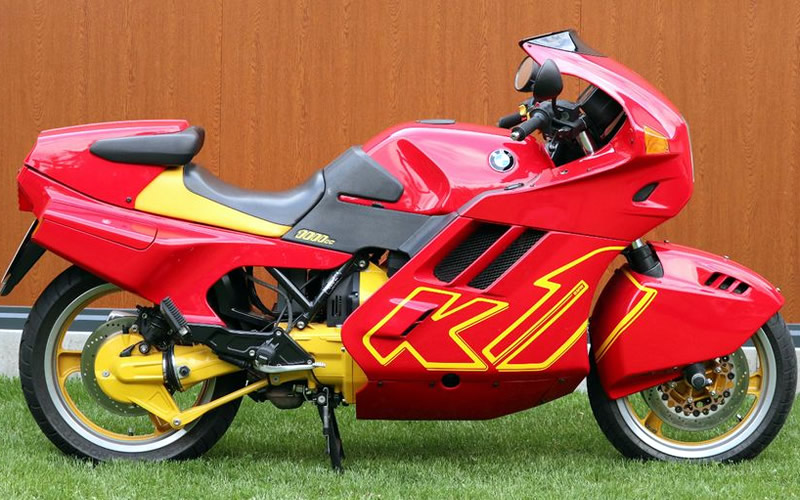
K 1, 1992 year, right view
The K1 is one of the first production motorcycles with full fairing, featuring a drag coefficient (cw value) of only 0.34 with a rider in a prone position. The seven-part fairing made of fiberglass-reinforced plastic is also the reason for its top speed of 240 km/h. Without the fairing, a top speed of approximately 210 km/h would be possible. The K1 was the first motorcycle from BMW to feature a 16-valve engine.
The liquid-cooled four-cylinder engine produces a rated output of 74 kW (100 hp) from a displacement of 987 cm³, delivering a maximum torque of 100 Nm at 6750 rpm. The four cylinders of the longitudinally mounted inline engine have a bore of 67 mm. The stroke of the four-stroke engine is 70 mm with a compression ratio of 11.0:1. The cylinder head has two chain-driven overhead camshafts that control two intake and two exhaust valves per cylinder via bucket tappets. Unlike the K100RS, the K1 does not have a mass air flow sensor in the airflow that would reduce power.
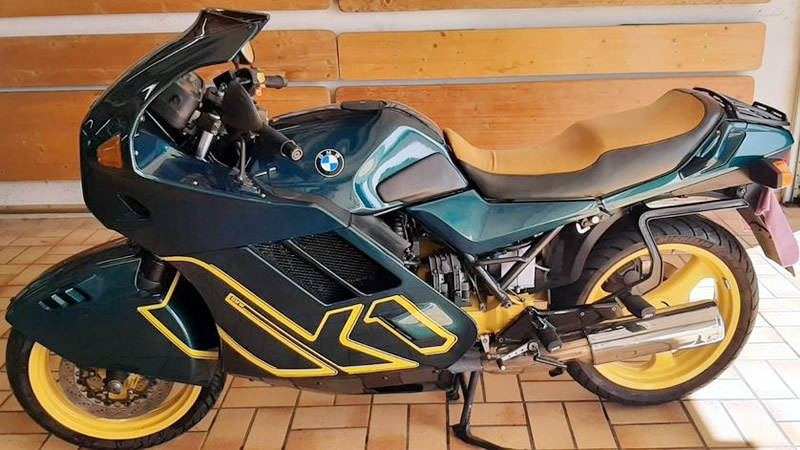
K 1, 1990 year, left view
The motorcycle accelerates from 0 to 100 km/h in 3.9 seconds. The rev limiter kicks in at 9170 rpm.
The chassis is based on that of the K100. To improve stability in fast corners, the tube diameters of the trellis frame were increased, and the chassis geometry was slightly altered, resulting in a wheelbase increase from 1516 mm to 1565 mm. Due to the fairing and the long wheelbase, the turning circle has a diameter of 6.7 m.
The front wheel is guided by a Marzocchi telescopic fork with hydraulic shock absorbers and 135 mm of travel. The rear wheel is mounted on a single-sided swingarm with a moment support (Paralever), designed to reduce load change reactions and brake squat. The weight-optimized three-spoke wheels made of lightweight metal are fitted with tubeless low-profile tires. The permissible total weight is 480 kg.
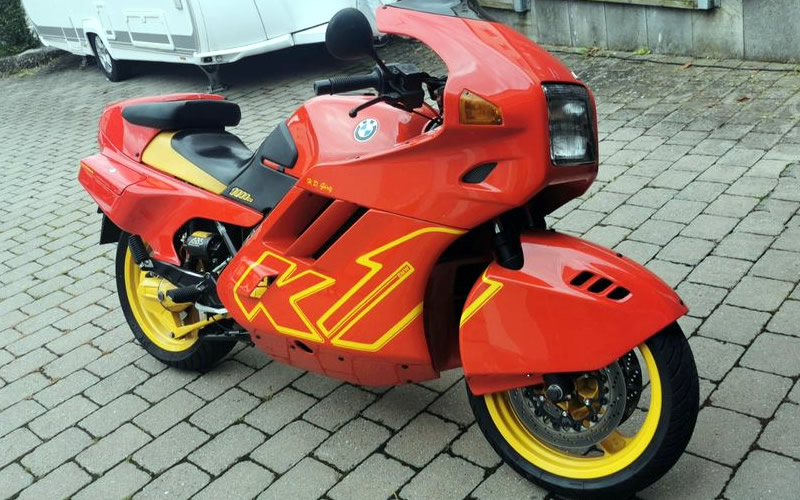
K 1, 1989 year, front view
According to ISO 7118, the average fuel consumption is 5 liters per 100 km at a speed of 120 km/h. The fuel tank has a capacity of 22 liters. The manufacturer recommends using unleaded gasoline with a minimum octane rating of 95. The 4-in-1 exhaust system exits on the left side of the vehicle at the height of the rear wheel hub into a muffler.

K 1, 1991 year, dashboard
For an additional cost, heated grips and an anti-lock braking system (ABS) were available, along with a catalytic converter. BMW did not offer touring cases, as BMW engineer Karl Heinz Abe explained: "Large integral cases would not only disrupt the aesthetics but also negatively affect the aerodynamic concept that allowed airflow from the front fender to the rear section". Instead, the motorcycle featured two storage compartments at the rear, each with a capacity of 6 liters.
BMW K1100 series
BMW K1100LT (1991-1998)
The BMW K1100LT is a motorcycle offered by BMW between 1991 and 1998. This tourer replaced the technically outdated predecessor model K100LT after five years of production. The K1100LT was the first BMW motorcycle to feature a longitudinally mounted 4-valve inline engine that was bored out from 987 cm³ to 1092 cm³ and utilized the Paralever rear suspension from the K100 sport versions and the K1. At its launch in 1991, it had a base price of 22,850 DM, making it the most expensive model in the BMW motorcycle lineup at that time. It was available for the first time with a regulated catalytic converter for an additional cost and, starting in 1993, the "Special Edition" introduced the first BMW model with a second-generation anti-lock braking system (ABS II). The designation LT stands for Luxury Tourer, with the internal factory code being 89V2 and the vehicle identification number 0526.

K 1100 LT, 1995 year, right view
The tourers K100RT and K100LT had sufficient success, with over 37,000 units sold by 1991, to continue the concept. However, despite updates, they fell behind the more advanced competition in terms of technology and performance. The two-valve engine with a displacement of 987 cm³ could not deliver the desired power delivery in higher gears and when heavily loaded, which customers demanded from touring motorcycles. A basis was provided by the four-valve engine with the same displacement from the K1, which was produced starting in 1988 and later used in the K100RS 4V. This engine already offered better power delivery and was further strengthened by boring it out to 1092 cm³. The cylinder bore was increased from 67 mm to 70.5 mm while the stroke remained the same. The nominally around 100 hp engine, with a maximum torque of 107 Nm, could be factory-restricted to an insurance-friendly 72 kW (98 hp), which made no measurable or noticeable difference in riding performance. This engine in the K1100LT was controlled for the first time by the newly developed Bosch Motronic 2.2 with throttle cutoff. The Paralever rear swingarm was also adopted from the two sport models, featuring a side-mounted, multi-adjustable gas pressure shock absorber. It replaced the Monolever from the predecessor model and reduced load change reactions of the shaft drive, which would otherwise lead to lifting and stiffening of the suspension during acceleration.
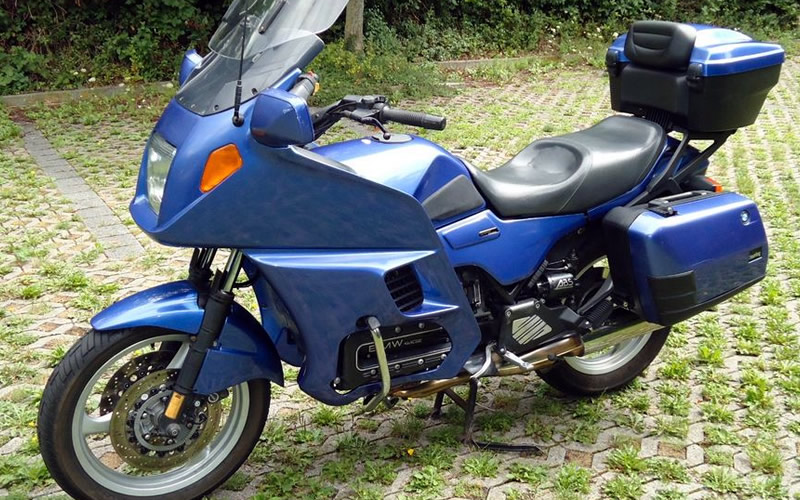
K 1100 LT, 1993 year, front view
Externally, the K1100LT appears only slightly modified; the full fairing was moved slightly further forward but was extended downwards around the engine. This change aimed to provide better wind protection with slightly increased legroom for the rider. The previously rigid fairing screen was replaced with an electrically adjustable screen in height and angle, and the flat top case was replaced with a taller one offering 35 liters of storage space, which was as easily removable as the two side cases. The extensive list of optional equipment included a regulated catalytic converter, ABS I, heated grips or foam rubber grips, a radio cassette player with remote control on the handlebars, additional 12-volt sockets, side crash bars, and an alarm system. With full equipment, the weight of the machine increased from the standard 290 kg to over 300 kg, and the total price already rose to around 28,500 DM in 1992 at the Berlin-Spandau factory.

K 1100 LT, 1992 year, dashboard
In 1993 and 1994, a numbered Special Edition (SE) was offered, which included some otherwise optional features and was the first to be equipped with the further developed and more sensitive ABS II. Additionally, the now over 9 kg heavy top case was equipped with a passenger backrest and two additional speakers for the standard stereo system. Generally, a regulated catalytic converter was standard, but the K1100LT SE could also be ordered without it. With full equipment, there was a price advantage of about 500 DM compared to a fully equipped standard model. In 1997, the Highline model version was introduced; for 29,600 DM, it was similarly equipped as the SE from four years earlier, but with additional visual features such as special colors and polished and chrome-plated engine and suspension parts.
BMW K1100RS (1992-1996)
The BMW K1100RS was a fully faired motorcycle manufactured by BMW, offered from September 1992 to 1996. This long-distance sport tourer is technically largely identical to the power-equivalent BMW K100RS 16V and allows for both sporty and moderate riding styles. A total of 12,179 K1100RS units were produced at the BMW factory in Spandau, Berlin.
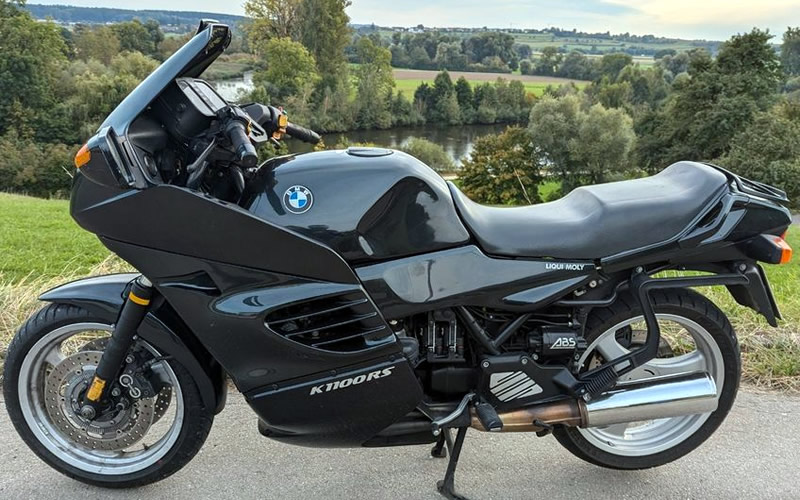
K 1100 RS, 1992 year, left view
The 1100 inline engine is a development of the lying four-cylinder engine from the K100, with its displacement increased by 10% through boring the cylinders. In line with the voluntary self-restraint of the motorcycle industry in Germany during the 1990s, the peak power was limited to 100 hp. Most of the delivered units were factory-restricted to 72 kW (98 hp) for insurance reasons, which is hardly noticeable during riding. However, the engine delivers enormous torque. From an engine speed of 3500 rpm, the drive produces over 90 Nm of torque, exceeding 100 Nm from 4500 rpm, and maintaining this up to the peak power at 7500 rpm. For riding, this means that there is ample propulsion available in almost every everyday riding situation. Fuel consumption (using super unleaded) varies between 5.0 and 8.5 liters, with full-throttle riding on the highway consuming up to 10 liters per 100 km.
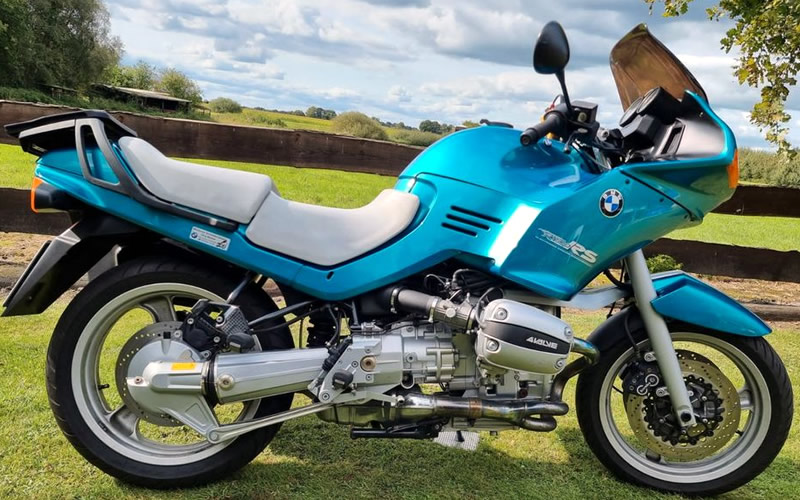
K 1100 RS, 1994 year, right view
The engine has some disadvantages, including an oil consumption of 0.3 to 1.0 liters per 1000 km and significant heating (the engine block of the K100 remained unchanged), as well as noticeable vibrations in the mid-range RPM depending on production variability.
In its last two production years, the K1100RS received the further developed ABS II, characterized by more sensitive control technology. The pressure modulators for the front and rear brake circuits, which were previously prominently displayed with ABS I, have now been integrated into a complete ABS control unit inside the machine.
To better dissipate engine heat, the full fairing of the K1100RS features gill-like ventilation openings on the sides, yet testers and owners complained of significant heat buildup on the thighs, especially in summer. This problem persisted throughout the RS's production period, and even BMW could not provide a satisfactory solution. The vibrations were dampened by handlebar end weights and vibration-isolated footpeg plates.

K 1100 RS, 1993 year, front view
The K1100RS boasts outstanding ergonomics and excellent wind protection for the rider. For example, the mirrors were positioned to provide a wind shadow for the hands. It is still considered virtually indestructible with regular maintenance. Additionally, despite its 268 kg dry weight (ready to ride), it is surprisingly nimble in tight corners and bends. A passenger enjoys a comfortable, spacious seat, while the rider hardly notices the presence of the passenger in terms of performance. BMW touring cases are also compatible and available. However, the K1100RS is purely a street machine and is completely out of place on gravel or in off-road conditions.
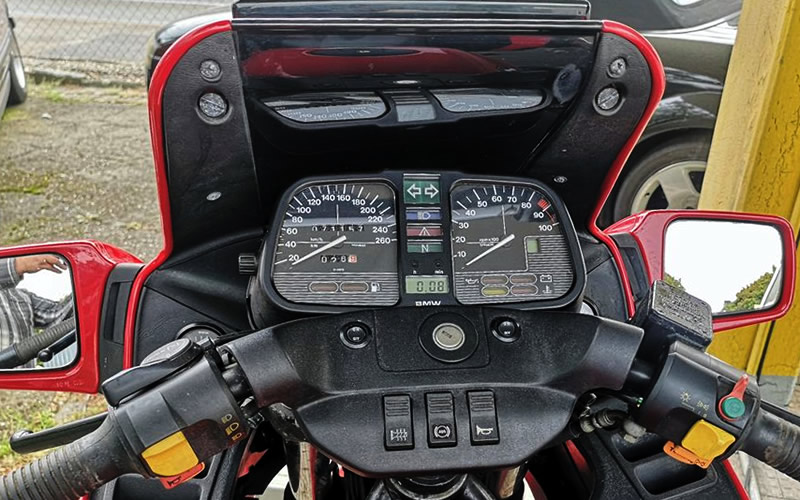
K 1100 RS, 1995 year, dashboard
As a youngtimer, the K1100RS is gaining popularity, especially since (as of 2021) well-maintained examples can still be found for relatively little money, can keep up with the handling and performance of modern motorcycles, and high mileage due to the generally robust technology is not a disqualifying factor. However, more and more K models are being modified in a more or less radical way, for example, in a café racer style.
The list price at the start of sales in 1992 was 21,950 DM. In spring 1997, the BMW K1200RS was introduced as its successor.
BMW K1200 series
BMW K1200GT (2002-2005)
The BMW K1200GT is a motorcycle produced by the German manufacturer BMW AG. This sport tourer is characterized by a powerful engine, good wind protection, a comfortable seating position, and a well-designed chassis. GT stands for Grand Tourismo, symbolizing, according to BMW, a cultivated sportiness combined with high touring comfort for the crew. The model codes for the two generations are K41 and K44.
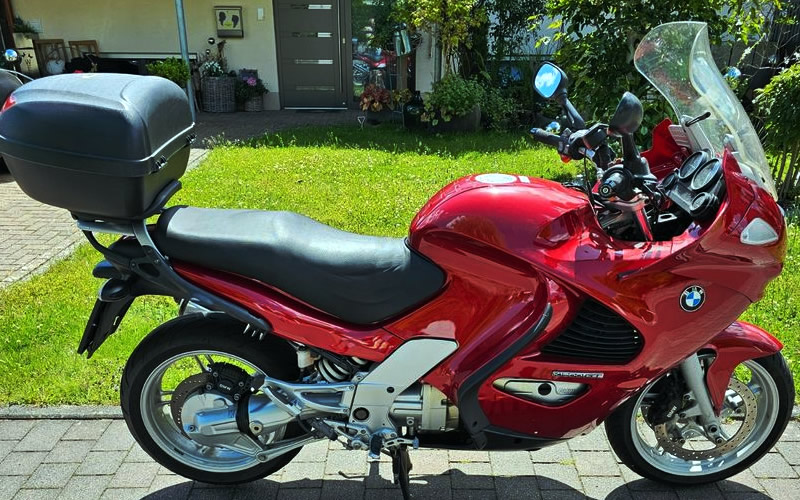
K 1200 GT K41, 2004 year, right view
1st Generation (K41, 2002-2005)
There are essentially two completely different motorcycles under the BMW K1200GT name. The first version was introduced at Intermot 2002. This model was based on the practically identical BMW K1200RS; among other things, the engine, chassis, and brakes are the same as those on the RS. The main differences from the BMW K1200RS include: a higher (electronically adjustable) windscreen, body extensions in the hand and leg areas, and standard side cases painted in the body color. Additionally, the noise level is more subdued than on the RS. Other advantages include greater seating comfort due to better-positioned handlebar halves and a higher seat that allows for a more comfortable knee angle.
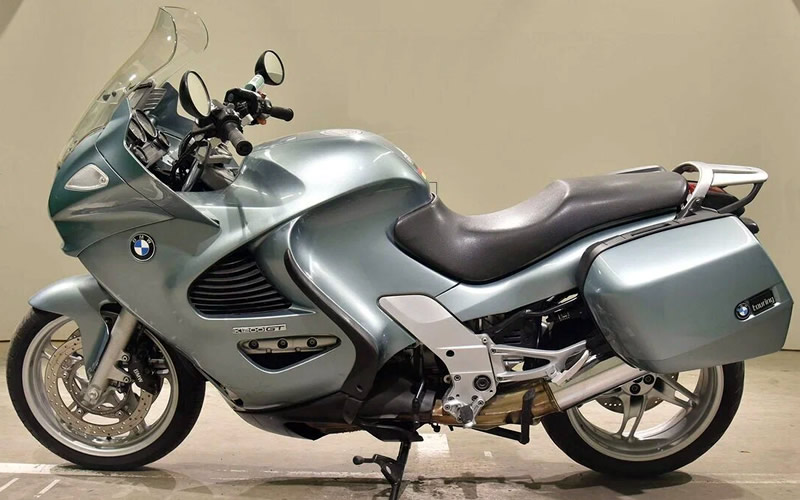
K 1200 GT K41, 2005 year, left view
This version was equipped with the longitudinally mounted inline four-cylinder engine (nicknamed "Flying Brick") and was delivered as standard with integral ABS from FTE automotive. The engine is a successor to the K100 engine from 1983, featuring modern technology such as fuel injection, a catalytic converter, exemplary low emissions, and respectable fuel consumption (6 liters per 100 km). Production ceased in 2005.
2nd Generation (K44, 2006-2008)
The K1200GT introduced in 2006 is a completely new motorcycle. Only the name and the underlying philosophy of Grand Tourismo remain. Behind the much more angular body hides the transverse four-cylinder engine from the K1200S and K1200R series, designed for more torque and less peak power. This model also features partial integral ABS from Continental Teves (without brake booster).
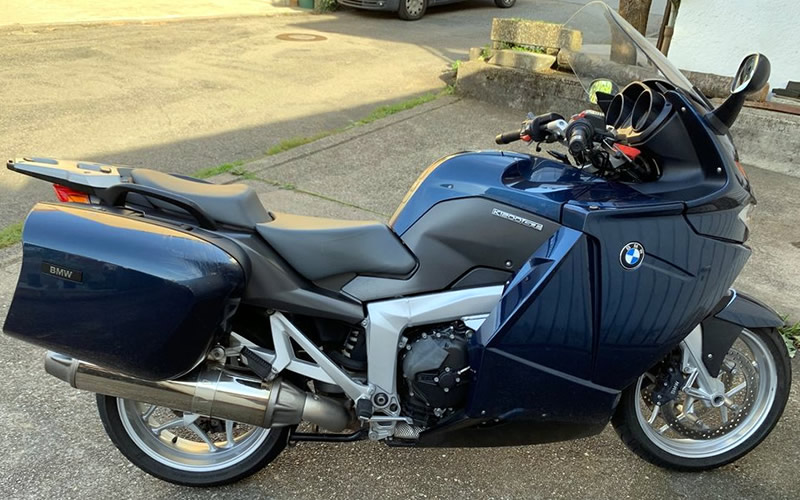
K 1200 GT K44, 2006 year, right view
The second generation of the K1200GT was replaced by the BMW K1300GT at the end of 2008.
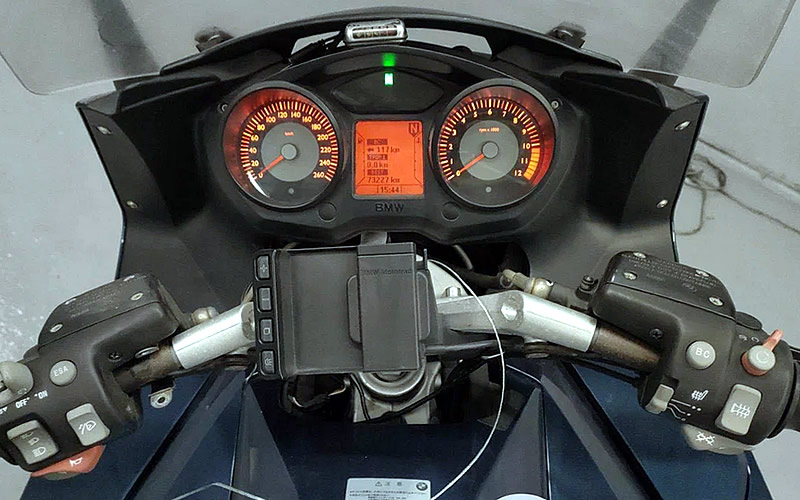
K 1200 GT K44, 2007 year, dashboard
BMW K1200LT (1998-2009)
The BMW K1200LT (for Luxury Tourer) is a touring motorcycle available from BMW from 1998 to 2009, initially offered for DM 34,400, and it replaced the K1100LT model. As a motorcycle in the super tourer category, the K1200LT was positioned as a competitor to the Honda Gold Wing, among others.
The K1200LT was already richly equipped in its first version from the Berlin-Spandau factory. Standard features included cruise control, a reverse assist activated by the starter, an onboard computer, a radio/cassette combination, and an electrically adjustable windscreen. Unlike the predecessor model, the non-removable luggage system with a top case and two side cases has a storage capacity of around 120 liters (with standard equipment; the optional CD changer reduces storage in the right case by a few liters). However, this brought the dry weight to over 385 kg, with a maximum payload of 213 kg.
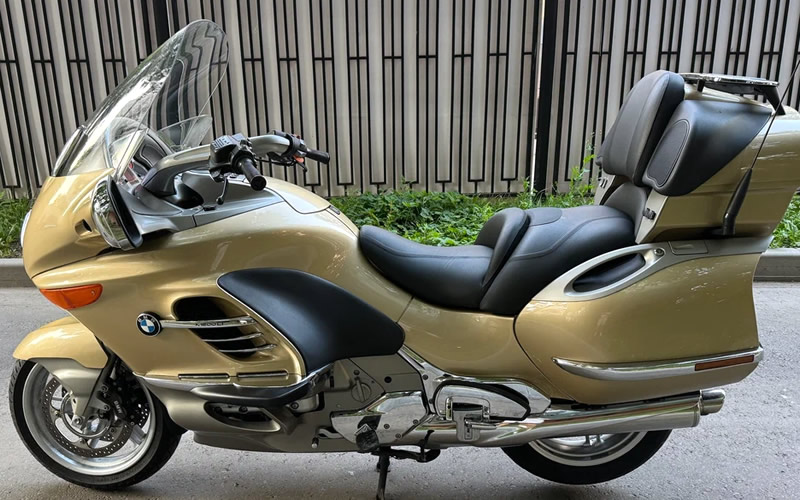
K 1200 LT, 2005 year, left view
The liquid-cooled four-cylinder engine was a further development of the horizontally mounted inline engine with 1100 cm³ displacement from the predecessor K1100 series. This engine had already been expanded and modified to 1200 cm³ for the K1200RS in 1996; the rated power increased to 130 hp. However, for the LT version, the engine was tuned for a broader, usable torque range (over 90 Nm just above idle and 115 Nm maximum torque at 4750 rpm) and a reduced peak power of insurance-friendly 98 hp. Instead of a choke like in the predecessor model, a cold start automatic with electronically controlled throttle positioner was installed; a regulated three-way catalytic converter was standard from the beginning (initially only on request for the K1100LT). The transmission has five gears, with the last one designed as overdrive. The engine cooling is achieved through two radiators supported by fans.
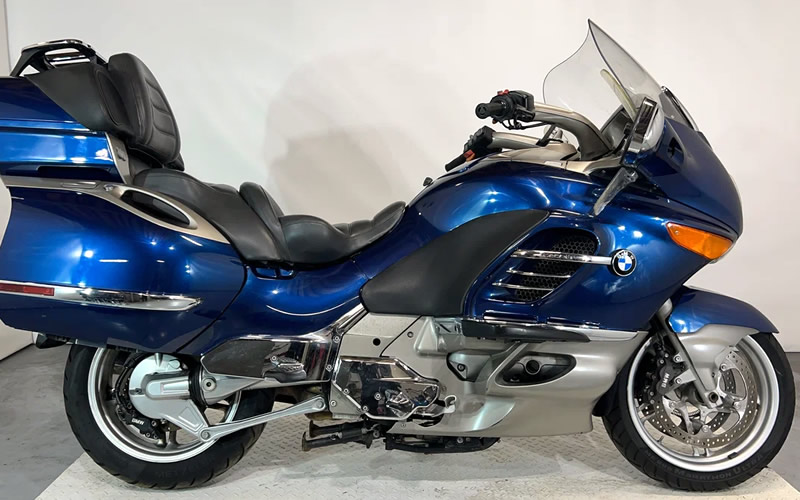
K 1200 LT, 2008 year, right view
The chassis is built on a very stable aluminum die-cast frame, with the engine not being a load-bearing element to avoid vibrations. Except for the rear Paralever shaft drive swingarm, it shares little in common with the predecessor model. The Telelever front swingarm is completely different from the previously used conventional telescopic fork suspension. The chassis and chassis geometry ensure good handling and a class-untypical "light" maneuverability despite the high vehicle weight. The fairing, fuel tank, seats, cases, and exhaust system are integrated into the body.
At the front wheel, braking is provided by a dual disc brake with a diameter of 305 mm and 4-piston calipers, while the rear features a floating disc brake with a diameter of 285 mm. The anti-lock braking system in its further developed second version requires high hand forces, which is why, in the fall of 2000, the brake-force-assisted integral ABS from FTE automotive was adopted as a full integral version into the series. This system was also installed in the K1200LT after August 2006 and not the new integral ABS from Continental-Teves, which has since been used in all other BMW motorcycles of the K and R series (except for the R1200S).
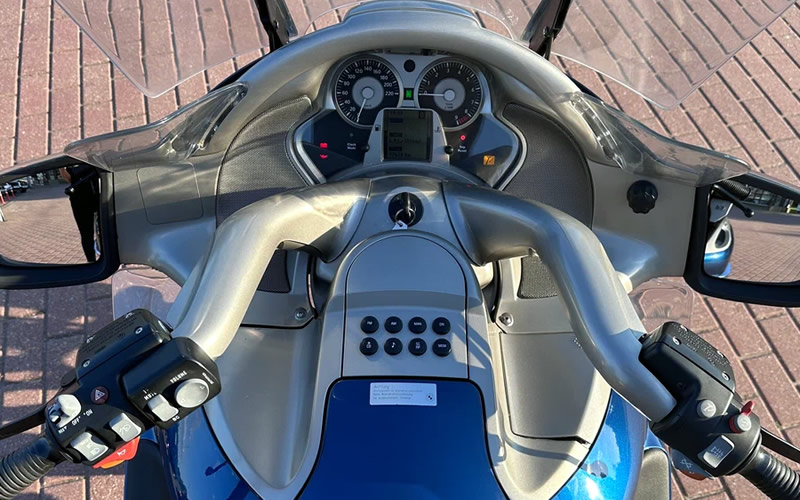
K 1200 LT, 2007 year, dashboard
In the 2004 model year, an updated model was introduced. The most important innovations included a more powerful engine with 85 kW (116 hp) and a maximum torque of 120 Nm, an electro-hydraulic main stand, a new rear suspension element with load-dependent damping, and optional xenon lighting. The base price in August 2006 was 20,500 euros.
BMW K1200R (2005-2008)
The BMW K1200R is an unfaired motorcycle manufactured by BMW, produced from 2005 to 2008 at the BMW factory in Spandau, Berlin. The naked bike was unveiled to the press on September 15, 2004, at Intermot in Munich, with sales starting on June 4, 2005.
The K1200R is technically very similar to the BMW K1200S, but it lacks full fairing, features a higher handlebar, modified power delivery, and changes in wheelbase and trail. The motorcycle accelerates from 0 to 100 km/h in 2.9 seconds and was the most powerful mass-produced muscle bike in the world until the presentation of the Suzuki B-King in 2007.

K 1200 R, 2007 year, right view
The liquid-cooled four-cylinder engine produces a rated output of 120 kW (163 hp) from a displacement of 1157 cm³ and delivers a maximum torque of 127 Nm at 8250 rpm. The cylinder head of the transverse inline engine features two overhead camshafts that control two intake and two exhaust valves per cylinder via rocker arms. The four cylinders of the four-stroke engine have a bore of 79 mm, and the pistons have a stroke of 59 mm with a compression ratio of 13:1. The top speed is 262 km/h.
The primary drive is achieved through helical gear wheels. Power separation is facilitated by a hydraulically operated multi-disc clutch in an oil bath, with torque conversion provided by a claw-shifted six-speed transmission. The secondary drive is via a shaft drive.

K 1200 R, 2006 year, left view
A digital engine control system regulates the electronic fuel injection with integrated knock control (BMS-K). The average fuel consumption is 5.5 liters per 100 km at a speed of 120 km/h. The fuel tank is made of plastic and has a capacity of 19 liters, with 4 liters reserved. The manufacturer recommends using motor gasoline with a minimum octane rating of 98. Exhaust after-treatment is handled by a regulated three-way catalytic converter, which meets the pollutant limits of the Euro-3 emission standard.
The chassis is built on an aluminum bridge frame, with the engine and transmission unit serving as a load-bearing element. The front wheel is guided by a Duolever with a central spring strut and 110 mm of travel. The rear wheel is supported by an aluminum die-cast single-sided swingarm with Paralever. The front brake features a dual disc with a diameter of 320 mm, while the rear has a single disc brake with a diameter of 265 mm. An optional switchable anti-lock braking system was available. The aluminum cast wheels have front dimensions of 120/70 ZR 17 and rear dimensions of 180/55 ZR 17.

K 1200 R, 2005 year, dashboard
Compared to the fully faired BMW K1200S, the R has a wider handlebar and a shorter fuel tank, allowing the rider to sit further forward and more upright. Combined with an 11 mm shorter trail at the front wheel, this results in slightly higher agility.
BMW K1200R Sport (2007-2008)
The BMW K1200R Sport is a partially faired motorcycle manufactured by BMW. The sport tourer was unveiled to the press on October 11, 2006, at Intermot in Munich. Sales of the fourth model in the K1200 series began in July 2007, with 1,347 units assembled at the BMW factory in Spandau, Berlin from 2007 to September 2008.
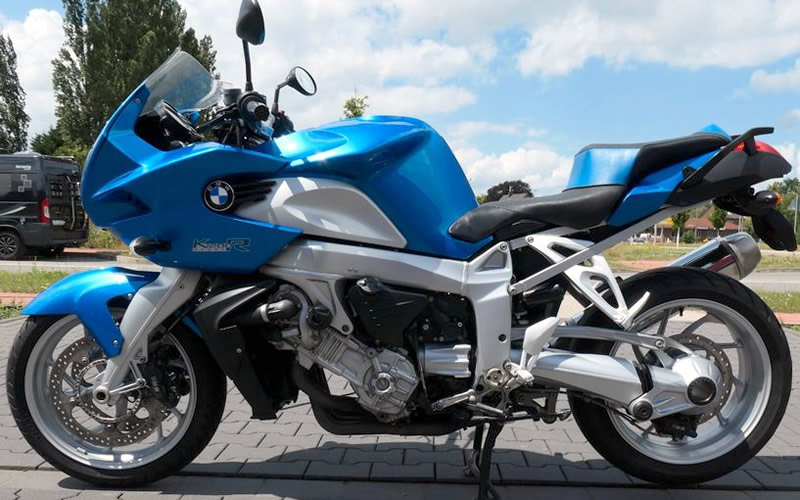
K 1200 R Sport, 2007 year, left view
The K1200R Sport is based on the naked bike BMW K1200R and shares the same drive and chassis technology, but is complemented by a frame-mounted half fairing with the asymmetrical headlights from the BMW R1200S. The ignition and injection electronics were recalibrated for a smoother throttle response and a more refined engine operation.
The liquid-cooled four-cylinder engine produces a rated output of 120 kW (163 hp) from a displacement of 1157 cm³ and delivers a maximum torque of 127 Nm at 8250 rpm. The cylinder head of the transverse inline engine has two overhead camshafts that control two intake and two exhaust valves per cylinder via rocker arms. The four cylinders of the four-stroke engine, which is tilted forward by 55 degrees, have a bore of 79 mm, and the pistons have a stroke of 59 mm with a compression ratio of 13:1.
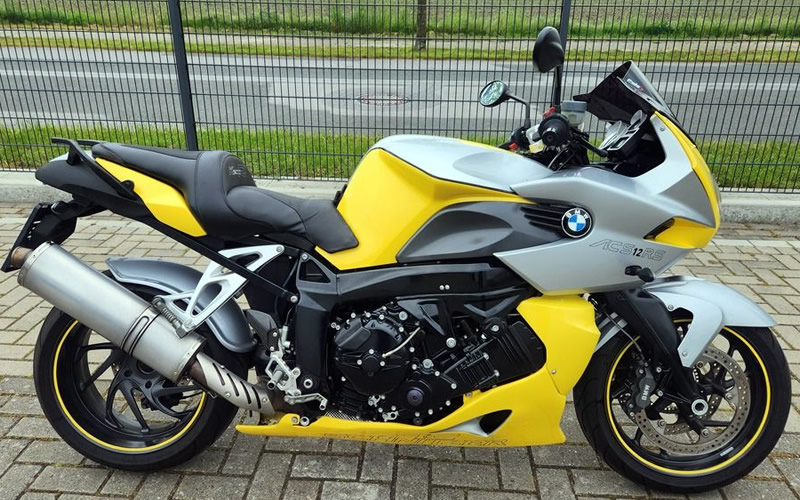
K 1200 R Sport, 2008 year, right view
The motorcycle accelerates from 0 to 100 km/h in 3.2 seconds and reaches a top speed of 264 km/h according to the registration certificate.
The primary drive uses helical spur gears. A hydraulically operated multi-disc clutch in an oil bath separates the power, while a claw-shifted six-speed transmission converts the torque. The secondary drive is via a shaft.
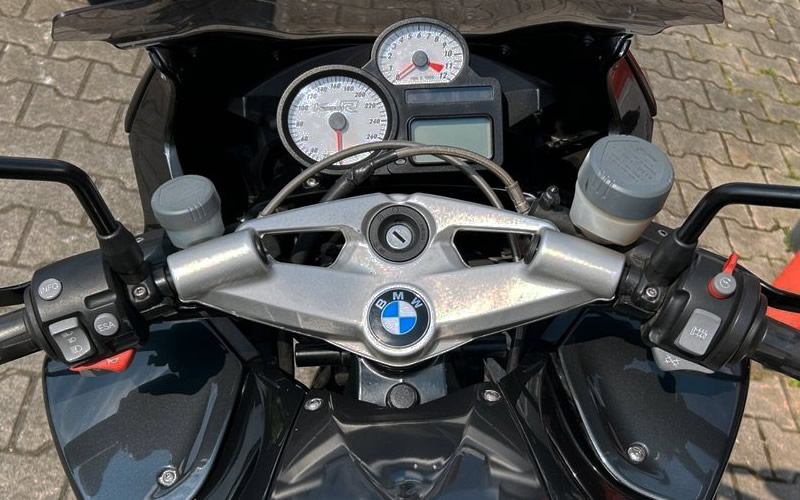
K 1200 R Sport, 2007 year, dashboard
A digital engine control system regulates the electronic fuel injection with integrated knock control (BMS-K). The average fuel consumption on country roads is 5.8 liters per 100 km. The fuel tank is made of plastic and has a capacity of 19 liters, with 4 liters reserved. The manufacturer recommends using motor gasoline with a minimum octane rating of 98. A regulated three-way catalytic converter treats the exhaust, ensuring that the pollutant limits of the Euro-3 emission standard are met.
The dry weight of the machine is 211 kg, and the permissible total weight is 450 kg. The motorcycle was offered in "Aluminium White Metallic" and "Cosmic Blue".
BMW K1200RS (1997-2005)
The BMW K1200RS is a long-distance motorcycle from BMW with a shaft drive. This sport tourer represents the final evolution of BMW's inline four-cylinder engines with a longitudinal layout (colloquially referred to as "Flying Brick"). From 1997 to 2005, a total of 37,992 units were produced at the BMW factory in Spandau, Berlin, of which 13,352 were registered in Germany.
The RS has a fully fueled weight of 295 kg (according to another source, 285 kg). Until 2000, the factory code was K589. In 2001, the RS was revised under the new model code K547. The fairing was modified at the front, the windscreen was enlarged, and the seating position was made slightly less sporty by lowering the footrests and raising the handlebars. Additionally, ABS II was replaced by the initially optional integral ABS.
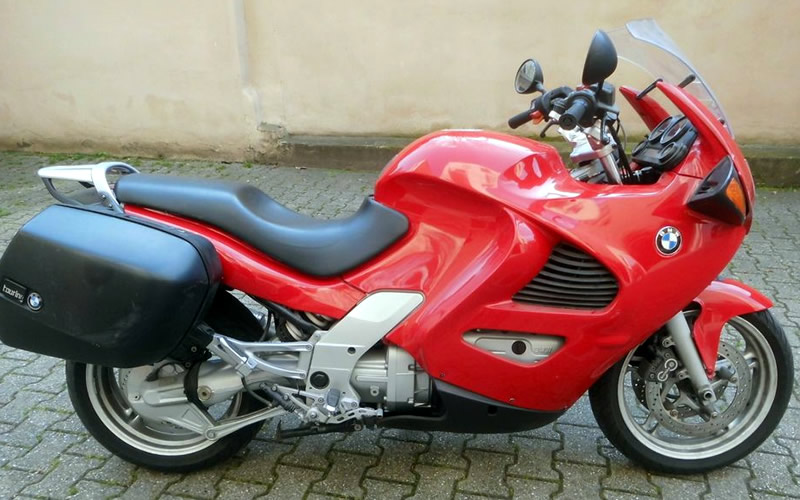
K 1200 RS, 1999 year, right view
Production of the K1200RS with a longitudinal engine ended in 2005. The nearly identical K1200GT (longitudinal engine version) was also discontinued in 2006. The only model to continue production until 2007 was the luxury tourer K1200LT. The direct successors to the K1200RS are the touring-oriented K1200GT (produced from 2006 to 2008) and the sporty K1200S (produced from 2004 to 2009), both featuring a transverse engine layout.
The liquid-cooled inline four-cylinder engine has a displacement of 1171 cm³ (bore 70.5 mm, stroke 75 mm). The rated output is 96 kW (130 hp), with a maximum torque of 117 Nm at 6750 rpm. The longitudinally mounted engine features two chain-driven overhead camshafts that control two intake and two exhaust valves per cylinder via bucket tappets. Compared to the predecessor engine of the K1100, the stroke was increased by 5 mm. The intake system is supported by a ram-air boost, supplied with air through an opening in the front fairing.

K 1200 RS, 2001 year, left view
The motorcycle accelerates from 0 to 100 km/h in 3.3 seconds and reaches a top speed of 245 km/h. Due to a manufacturer's self-restriction, the motorcycle was mostly delivered in Germany and France in a version limited to 72 kW (98 hp) until 2001. This version features a slightly higher torque at significantly lower RPM (118 Nm at 5500 rpm), making it better suited for riding with two people and relaxed cruising. It also reaches its maximum power significantly earlier at an RPM of 7000. The K1200RS features one of the first fully digital ignition and fuel injection systems, a Motronic from Robert Bosch GmbH.
Power is transmitted from the engine to the transmission via gears (primary drive). The clutch is a hydraulically operated single-disc dry clutch, and the transmission has six gears. The secondary drive is via a shaft drive with a moment support known as Paralever, which reduces rear-end lift during hard acceleration.
Fuel preparation is managed by fuel injection controlled by a Bosch Motronic MA 2.4 with throttle cutoff. The fuel tank has a capacity of 22 liters, of which 4 liters are reserved. The manufacturer recommends using gasoline with an octane rating of at least 95 and states a theoretical range of 312 km. The average fuel consumption is 6.9 liters per 100 km.

K 1200 RS, 2002 year, dashboard
For exhaust after-treatment, the K1200RS has two regulated catalytic converters and meets the Euro-2 emission standard.
The chassis is built on an aluminum cast frame. It features a double-joint single-sided swingarm at the rear, while the front wheel is guided by a Telelever. The rear wheel is offset by 5 mm to balance the slight weight bias on the right side.
The front wheel is equipped with a dual disc brake from Brembo with four-piston calipers, while the rear features a disc brake with a two-piston caliper. A standard anti-lock braking system (ABS) supports braking at both brakes. The lean angle clearance is 50 degrees.
BMW has mitigated the unpleasant vibrations of earlier K models by separating the drive unit from the frame and using rubber isolators. The long wheelbase of 1549 mm ensures good ride stability. The seat height is adjustable from 769 to 793 mm.
BMW K1200S (2004-2008)
The BMW K1200S is a sport touring motorcycle from the German vehicle manufacturer BMW and was the most powerful production motorcycle from Germany until the end of 2008. The fully-faired motorcycle was introduced in July 2004 and went on sale in early summer 2005. Originally, the sales launch was scheduled for September 2004 but had to be postponed due to quality issues at the factory. In August 2008, production was discontinued in favor of the successor model, the BMW K1300S.
Comparable competing models include the Suzuki Hayabusa 1300 and Kawasaki ZZR1400. The "S" in the sales designation stands for Sport, and the internal factory code is K40.
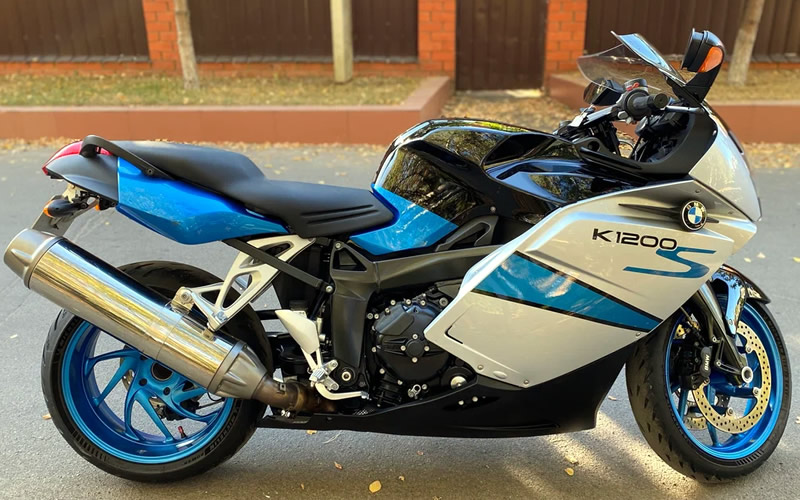
K 1200 S, 2007 year, right view
The official fuel consumption figures are 4.7 liters (Super Plus, at a constant speed of 90 km/h) and 5.5 liters (at a constant speed of 120 km/h). During brisk test rides, mixed consumption figures of 6.3 liters of Super Plus were recorded. The list price for the base version was €15,200 in the fall of 2006.
From the K1200S, there are also sibling models K1200R (Power roadster K43), K1200R Sport (half-faired sport tourer K43 HV), and the touring model K1200GT (K44).
For the K models starting from the K1200S, BMW Motorrad developed an entirely new water-cooled four-cylinder engine. The engine is rigidly mounted in the chassis with 8 bolts. The inline engine is installed transversely, with the cylinder bank tilted extremely forward at 55°. This installation position requires a second angle drive because the final drive is done with a drive shaft instead of the typical chain drive. The 6-speed transmission can also be ordered with a quick-shifter.
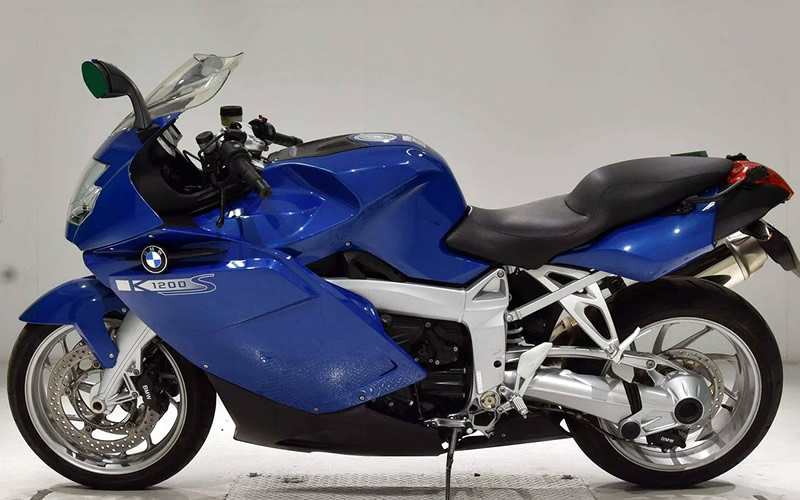
K 1200 S, 2005 year, left view
The engine is equipped with two overhead camshafts and four valves per cylinder, electronic fuel injection, and a regulated three-way catalytic converter. Vibration balance is achieved with two counter-rotating balance shafts according to the Lanchester principle.
With a displacement of 1,157 cm³, the engine produces a rated output of 123 kW (167 hp) at a speed of 10,250 rpm. The manufacturer specifies the maximum torque as 130 Nm at 8,250 rpm. The top speed is stated by the manufacturer as "over 200 km/h"; according to test reports, it is about 280 km/h. Acceleration figures from these tests show 0 to 100 km/h in 2.8 seconds and 0 to 200 km/h in approximately 8.5 seconds.
The chassis is a completely new development. This was necessary because the engine was installed transversely to the direction of travel compared to its predecessor, the K1200RS, and the Evo Paralever rear wheel guidance was executed with Pro-Link and an overhead torque support. The single-sided swingarm was made very torsionally rigid in aluminum casting.
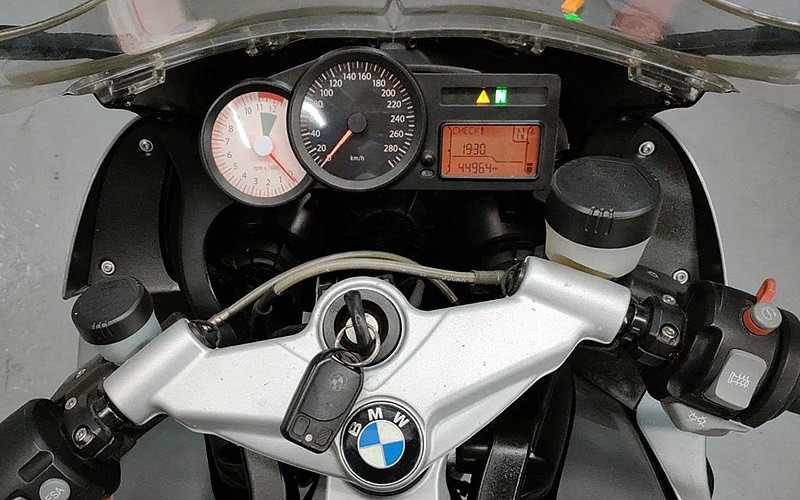
K 1200 S, 2006 year, dashboard
The main frame is an aluminum welded construction made of cast components, extruded profiles, and hydroforming profiles. It consists of a steering head that houses the steering, a bearing bracket that supports the two longitudinal arms and the front shock absorber, two engine mounts, and a four-part rear section. The front and rear main frames are connected by two hydroforming profiles. The main frame was developed by Hartwin Falk, who was also responsible for the frames of the K75, K100RS, K1, K1100, and K1200. The rear frame, weighing under 2 kg, is the benchmark in this vehicle class, as the K1200S still has a payload of 200 kg. It was designed by Frank Lanner. The frames are manufactured at the BMW factory in Berlin.
The rear wheel is guided by a single-sided swingarm made of aluminum casting with Paralever. The rear shock absorber is connected to the frame and swingarm using a Pro-Link system. The front wheel is guided by the Duolever lever system with a central shock absorber, which was used for the first time in a production motorcycle.
BMW K1300 series
BMW K1300GT (2009-2011)
The BMW K1300GT is a fully faired motorcycle from Bayerische Motoren Werke. The sport tourer was unveiled to the press on October 7, 2008, at the Intermot motorcycle show in Cologne. Like all models in the K series, the motorcycle was manufactured at the BMW factory in Spandau, Berlin, and was replaced by the K1600GT in 2011. The abbreviation GT stands for Grand Tourismo.
Comparable competing models include the sport tourers Yamaha FJR1300, Kawasaki 1400GTR, Moto Guzzi Norge 1200/GT 8V, and Honda ST1300 Pan European.
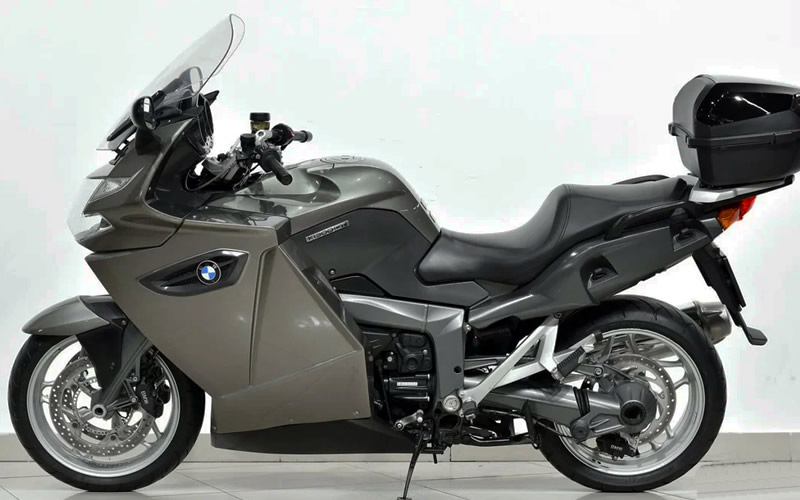
K 1300 GT, 2010 year, left view
The BMW K1300GT is a sport tourer with a powerful engine, good wind protection, a comfortable seating position, and a well-designed chassis. This model is based on the BMW K1200GT.
The liquid-cooled four-cylinder engine produces a rated output of 118 kW (160 hp) from a displacement of 1293 cm³ at an engine speed of 9000 rpm and delivers a maximum torque of 135 Nm at 8000 rpm. The four cylinders of the inline engine have a bore of 80 mm, and the piston stroke is 64.3 mm. The compression ratio is very high at 13.0:1. The two chain-driven overhead camshafts operate two intake and two exhaust valves per cylinder via rocker arms.
The motorcycle accelerates from 0 to 100 km/h in 3.3 seconds and reaches a top speed of 260 km/h.
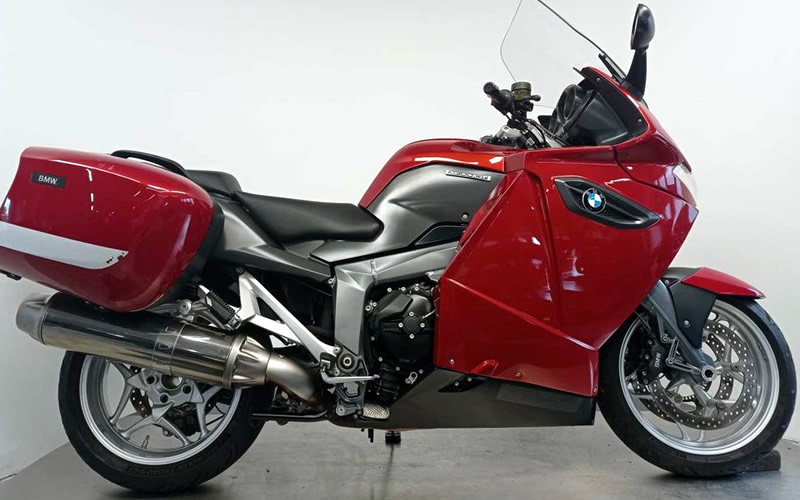
K 1300 GT, 2009 year, right view
In the primary drive, gears connect the crankshaft to the clutch shaft. A hydraulically operated multi-disc clutch rotates in an oil bath and separates the engine from the transmission. The claw-shifted transmission features helical gearing and has six gears. In the secondary drive, a shaft drive transmits engine torque from the transmission output via a joint shaft to the rear axle. Elastomer elements in the two-stage joint shaft are intended to reduce load change reactions. A moment support known as Paralever above the single-sided swingarm reduces the disruptive reaction forces of the shaft drive during acceleration and deceleration.
The starter battery has a capacity of 19 amp-hours and powers the electric starter, while the alternator generates 945 watts. The onboard computer communicates with the electronic control components of the engine and chassis via a CAN bus. The taillight is equipped with standard bulbs. Optional features include xenon lighting, seat and grip heating, and a cruise control system.
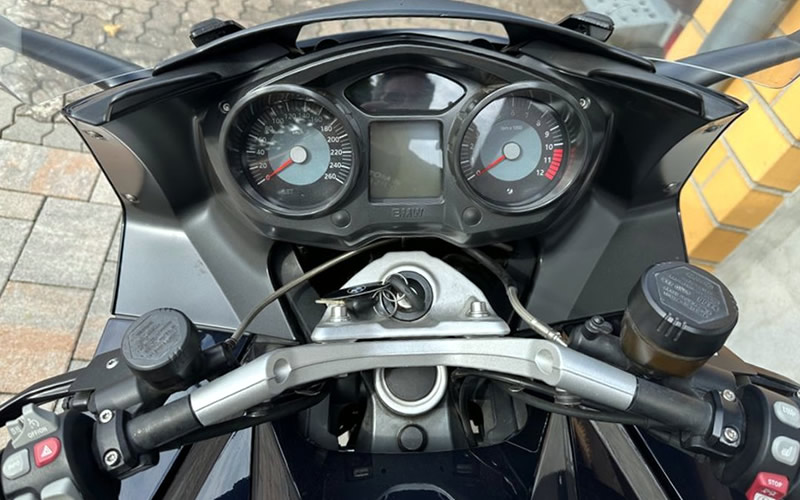
K 1300 GT, 2011 year, dashboard
The engine is equipped with computer-controlled fuel injection and transistor ignition. The average fuel consumption is 5.8 liters per 100 km. The fuel tank has a capacity of 24 liters, with 4 liters reserved. The manufacturer recommends using unleaded gasoline with an octane rating of at least 95. The theoretical range is 414 km. A regulated three-way catalytic converter reduces pollutants below the limits of the Euro-3 emission standard. The 4-in-1 exhaust system exits on the right rear side of the vehicle into a muffler.
The chassis is built on an aluminum bridge frame, with the rear frame bolted on. The steering head angle is 60.6 degrees, resulting in a trail of 112 mm. The front wheel is guided by a Duolever suspension with 115 mm of travel and is braked by a dual disc brake with four-piston calipers. The rear wheel is attached to a double-joint single-sided swingarm made of aluminum and is braked by a disc brake with a two-piston floating caliper. An anti-lock braking system (ABS) supports braking at both brakes, with the foot brake acting on the rear wheel and the hand brake acting on both wheels. An automatic stability control (ASC) and a suspension support system called Electronic Suspension Adjustment (ESA) are offered as options. The motorcycle can decelerate from 100 km/h to a standstill with an average deceleration of 10.13 m/s², requiring a braking distance of 38 meters. The GT weighs 298 kg when fully fueled, with a maximum payload of 222 kg.
BMW K1300S (2008-2015)
The BMW K1300S is a motorcycle manufactured by BMW. The sport tourer was presented at the Intermot motorcycle show in Cologne on October 7, 2008, and was produced until September 2015 at the BMW factory in Spandau, Berlin. This fully faired motorcycle is a constructive evolution of the BMW K1200S and, like all models in the K series, is powered by an inline engine.
On the occasion of the 25th anniversary of the K series, the development of the K1200S was introduced in 2008, from which a total of 60,000 units were produced. By increasing the cylinder bore by one millimeter and the piston stroke by 5.3 millimeters, the displacement grew by 136 cm³. The engine's redesign was overseen by Ricardo, who also designed the transmission for the Bugatti Veyron. An improved drive shaft in the rear drive reduced noise levels and improved shifting. To optimize airflow, the airbox and intake channels were modified. The transmission and electronically controlled suspension support were also revised. Engine power increased by 6 kW (8 hp), and the maximum torque increased by 10 Nm.
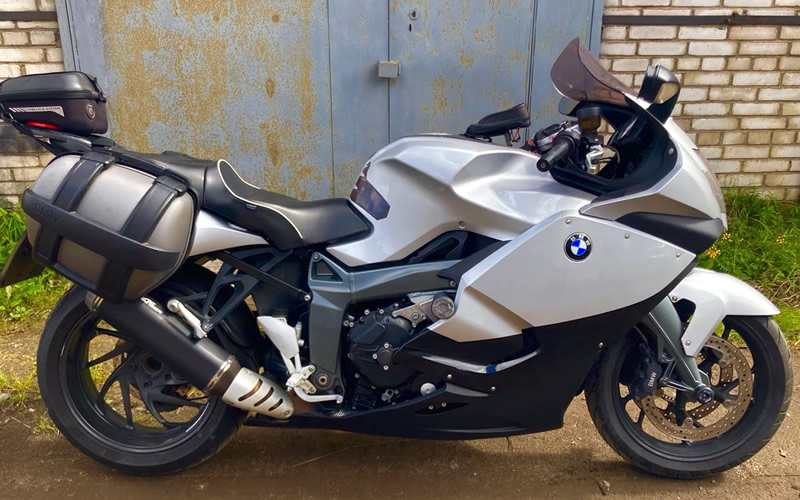
K 1300 S, 2012 year, right view
Sales began in February 2009 at a base price of €15,750. Motorcycles with comparable engine characteristics and chassis geometry include the Suzuki Hayabusa 1300, Kawasaki ZX12R, and Honda CBR1100XX.
The liquid-cooled four-cylinder engine produces a rated output of 129 kW (175 hp) from a displacement of 1293 cm³ at an engine speed of 9250 rpm, delivering a maximum torque of 140 Nm at 8250 rpm. The cylinders have a bore of 80 mm, the piston stroke is 64.3 mm, and the compression ratio is 13.0:1. The two chain-driven overhead camshafts operate two intake and two exhaust valves per cylinder via rocker arms. The transverse four-stroke engine weighs 82.8 kg and is tilted forward by 55 degrees to lower the overall center of gravity.
The motorcycle accelerates from 0 to 100 km/h in 2.9 seconds and reaches a top speed of 285 km/h. The braking distance from 100 km/h to a standstill is 37.3 meters, with an average deceleration of 10.3 m/s².
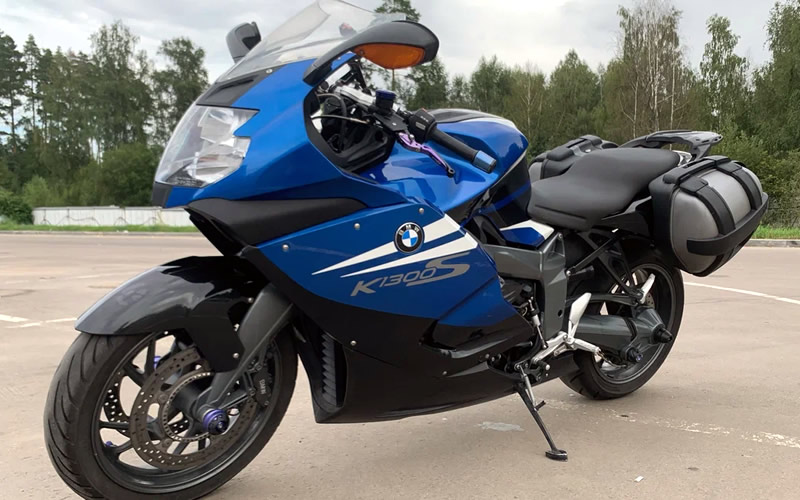
K 1300 S, 2010 year, front view
In the primary drive, gears connect the crankshaft to the clutch shaft. A hydraulically operated multi-disc clutch rotates in an oil bath and separates the engine from the transmission. The claw-shifted transmission features helical gearing and has six gears. A shaft drive connects the transmission output to the rear axle in the secondary drive. A moment support known as Paralever above the single-sided swingarm reduces the inherent reaction forces of the shaft drive during acceleration and deceleration.
An optional quick-shifter is available, which is mounted between the shift lever and the transmission shaft, allowing for upshifts without engaging the clutch. When the shift lever is pulled, ignition and injection are interrupted for 50 milliseconds.
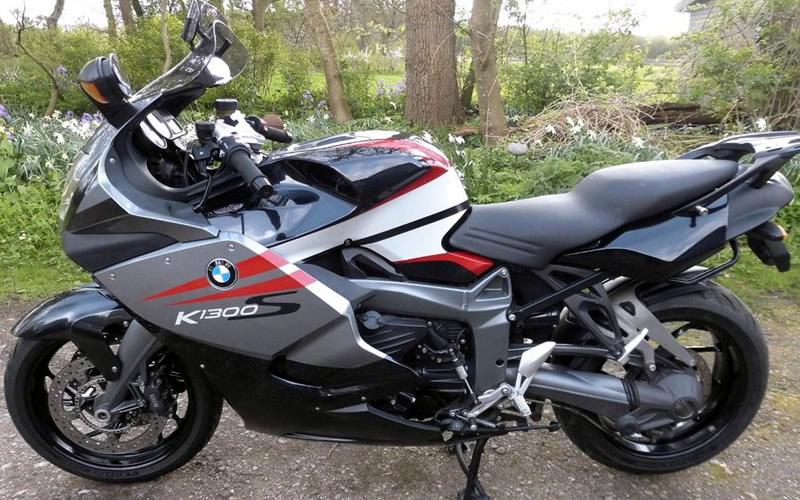
K 1300 S, 2009 year, left view
A computer-controlled fuel injection system pumps fuel through injectors into the cylinders, where it is ignited by a transistor ignition system. The average fuel consumption is 5.8 liters per 100 km. The fuel tank has a capacity of 19 liters, with 4 liters reserved. The manufacturer recommends using unleaded gasoline with an octane rating of at least 95. The theoretical range is 327 km. A regulated three-way catalytic converter reduces pollutants below the limits of the Euro-3 emission standard. The four exhaust headers of the exhaust system exit on the right rear side of the vehicle into a muffler.
The chassis is built on an aluminum bridge frame, with the rear frame bolted on. The front wheel is guided by a Duolever suspension with 115 mm of travel and is braked by a dual disc brake with four-piston calipers. The rear wheel is attached to an aluminum single-sided swingarm and is braked by a disc brake with a two-piston floating caliper. A partial integral anti-lock braking system (ABS) supports braking at both brakes, with the foot brake acting only on the rear wheel and the hand brake acting on both wheels. An automatic stability control (ASC) is offered as an option. The forward-tilted cylinder bank with frame profiles spanning over the engine allows for a narrow knee closure.

K 1300 S, 2011 year, dashboard
An Electronic Suspension Adjustment (ESA2) system is available as an accessory. ESA2 electronically controls the rebound damping of the front and rear shock absorbers, as well as the spring base of the rear shock, adjusting the spring rate via an elastomer element. This allows the suspension damping to be electronically adapted to riding style, load, and road conditions.
BMW K1300R (2009-2016)
The BMW K1300R is a motorcycle manufactured by BMW and was produced from 2009 to 2016 at the BMW factory in Spandau, Berlin. This naked bike is technically largely identical to the BMW K1300S, but it lacks full fairing and features a higher handlebar. The successor to the BMW K1200R was presented to the press on October 7, 2008, at Intermot in Munich.

K 1300 R, 2009 year, left view
The liquid-cooled four-cylinder engine produces a rated output of 127 kW (173 hp) from a displacement of 1293 cm³ at an engine speed of 9250 rpm, delivering a maximum torque of 140 Nm at 8250 rpm. The transverse inline engine features four valves per cylinder. The four cylinders have a bore of 80 mm and a stroke of 64.3 mm. The four-stroke engine has a compression ratio of 13:1.

K 1300 R, 2013 year, right view
The chassis consists of an aluminum bridge frame and a load-bearing engine. The front wheel is guided by a Duolever with a central spring strut and 115 mm of travel, while the rear wheel is supported by an aluminum die-cast single-sided swingarm with Paralever and 135 mm of travel. The front tire size is 120/70 ZR 17, and the rear tire size is 180/55 ZR 17. The fuel tank has a capacity of 19.0 liters, with 4.0 liters reserved. The dry weight is 217 kg, and the curb weight is 243 kg.
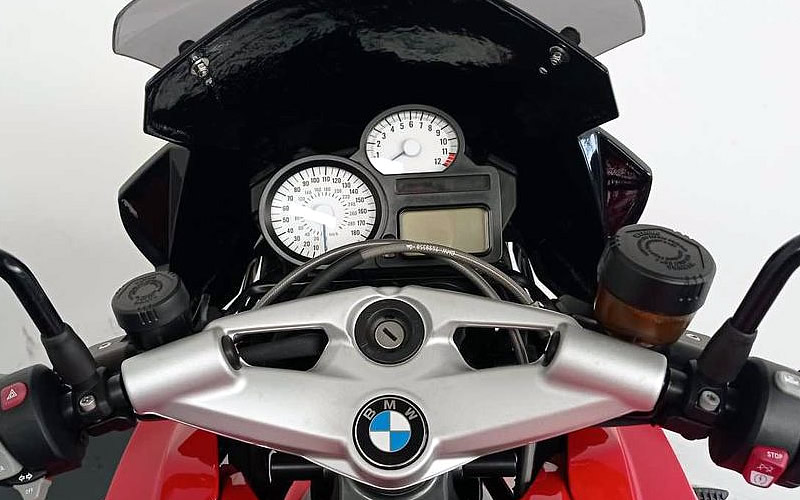
K 1300 R, 2012 year, dashboard
Power is transmitted through a multi-disc clutch in an oil bath, a claw-shifted six-speed transmission, and a shaft drive. The front wheel is braked by a dual disc brake with a diameter of 320 mm, while the rear features a single disc brake with a diameter of 265 mm. An optional partial integral anti-lock braking system regulates the braking system. The average fuel consumption is 7.2 liters of super gasoline per 100 km at a speed of 120 km/h. Standard features include a digital engine management system (BMS-K) with electronic fuel injection, integrated knock control, and throttle cutoff.
The motorcycle accelerates from 0 to 100 km/h in 2.9 seconds and reaches a top speed of 270 km/h.
BMW K1600 series
BMW K1600GT (2011-current)
The BMW K1600GT is a motorcycle manufactured by BMW. It was unveiled at the Intermot motorcycle show in October 2010, with market launch in March 2011 at a base price of €19,900; by 2017, this price had risen to €22,050. Until the model update in February 2022, approximately 68,000 units were sold.
The BMW K1600GT is powered by a six-cylinder gasoline engine designed for compact width, high torque at low RPM (with over 100 Nm available just above idle), and low weight. The engine block is made of aluminum alloy. The bore measures 72 mm, with 5 mm thick webs between the cylinders. Through design measures, such as the (driven by a roller chain) camshaft with a wall thickness of 3 mm, the total weight reaches 102.6 kg. This makes the engine 25 kg heavier than the approximately equally powerful engine of the BMW K1300GT, from which it also inherited the 55-degree tilt of the cylinder bank. However, it is about 7.5 kg lighter than the large boxer engine introduced in the 2020 R18.
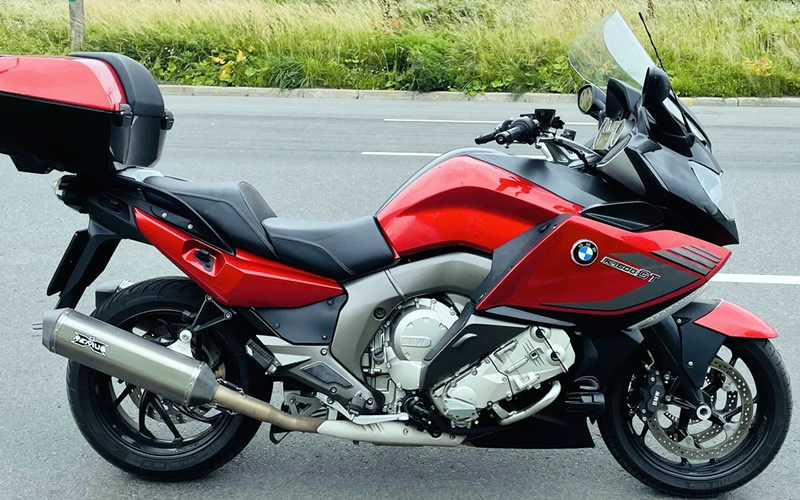
K 1600 GT, 2014 year, right view
The engine features an electronically controlled throttle with a diameter of 52 mm instead of the usual single throttle valves found on motorcycles, as it would have otherwise exceeded the specified width of 555 mm due to the crank drive. The engine uses electronically regulated manifold fuel injection. The compression ratio is 12.2:1.
The engine allows acceleration from 0 to 100 km/h in 3.2 seconds. The newspaper Die Welt reported in 2018 that the heavier Grand America model had a fuel consumption between 5.2 and 7.0 liters per 100 km. In 2022, the engine was updated with an additional catalytic converter, two more lambda sensors, adjustments to the knock sensor, and a new engine control unit to comply with Euro 5 emissions standards. CO2 emissions are 137 g/km. The 118 kW is now achieved at 6750 rpm, and torque increased by 5 Nm to 180 Nm. The electronically controlled rev limit is set at 9000 rpm.

K 1600 GT, 2018 year, left view
The bridge frame is made of aluminum. The rear wheel is guided by a double-joint single-sided swingarm, also made of aluminum. The front wheel is managed by a Duolever construction with a central spring strut. Three riding modes ("Rain" (which alters throttle response and limits power to 112 kW), "Road," and "Dynamic") can be switched via a button on the right handlebar, and ABS is standard equipment. An electronically adjustable suspension (ESA II) is available as an option, allowing it to be adapted to asphalt conditions, load, and riding style.
As the first motorcycle in the world, the K1600GT offers optional adaptive cornering lights, which provide better illumination of the road during nighttime cornering. A pivoting mirror in the design of the xenon low beam compensates for up to 25 degrees of lean angle. With the 2022 model update, LED lighting was introduced, which now also includes a two-degree horizontally tilting pivot light to compensate for acceleration. Additionally, the analog instruments were replaced by a 10.25-inch TFT display.
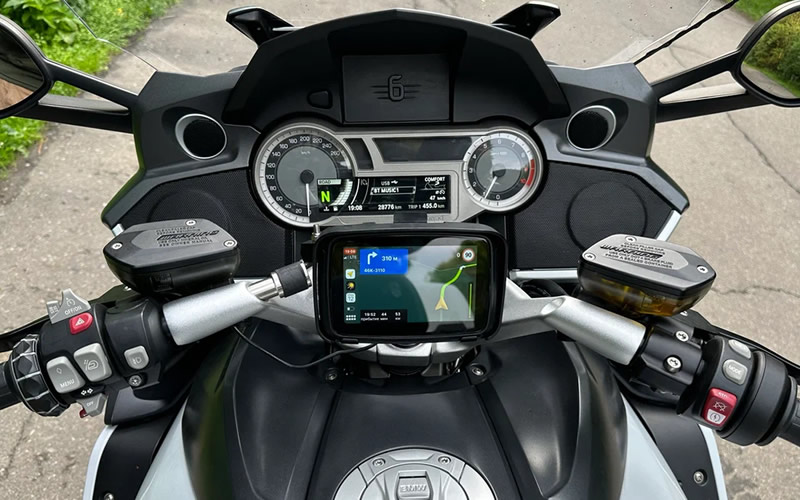
K 1600 GT, 2016 year, dashboard
Since 2017, an electric reverse assist that utilizes the electric starter and a quick-shifter have been offered as extras. The instruments have been slightly revised.
BMW K1600GTL (2011-current)
The K1600GTL has been further developed as a long-distance tourer, featuring additional amenities such as a more comfortable one-piece seat, a more pronounced bend in the handlebars towards the rider, rubberized footrests, and an increased fuel tank capacity from 24 to 26.5 liters.

K 1600 GTL, 2012 year, left view
The BMW K1600GTL comes standard with a top case, which can be equipped with a second, elevated brake light for an additional charge. More chrome parts on the side fairing, wind flaps, and the chrome end silencers further distinguish it from the K1600GT; they contribute to a quieter, more subdued engine sound compared to the GT version. The list price in Germany at launch was €21,850, increasing to €27,950 with the 2022 model update.
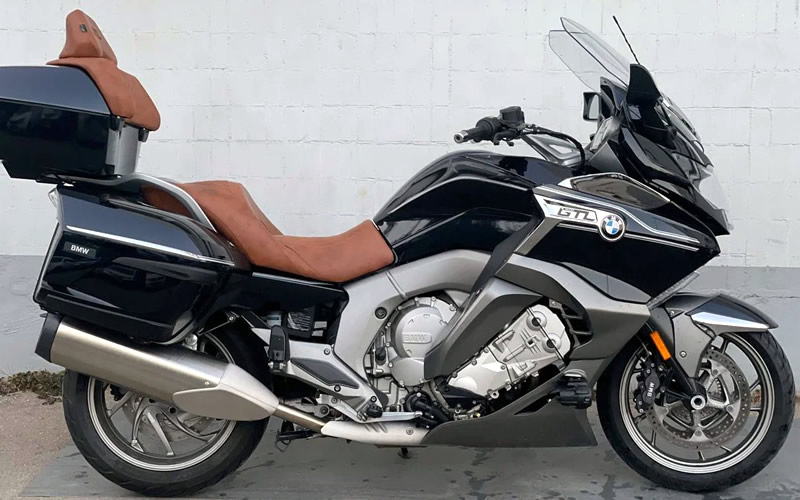
K 1600 GTL, 2019 year, right view
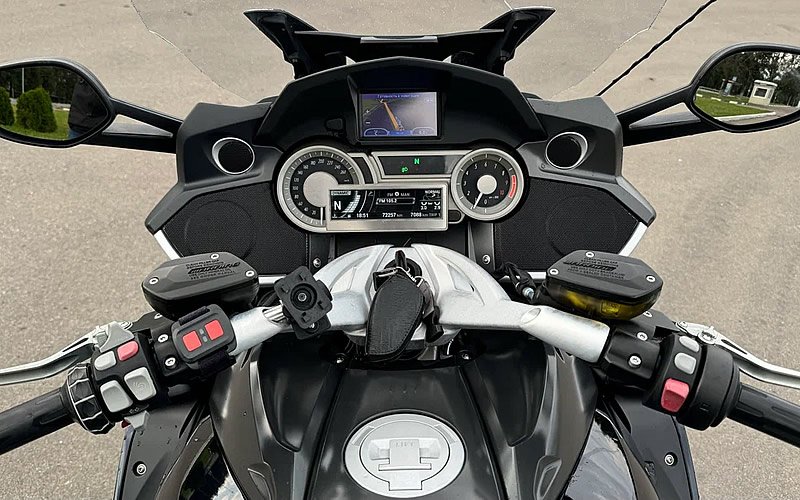
K 1600 GTL, 2013 year, dashboard
BMW K1600B (2017-current)
In March 2017, BMW introduced the K1600B. This version features a lowered rear frame and teardrop-shaped saddlebags with vertically oriented, curved taillights and 17-inch forged wheels. At its introduction, it was priced at €21,900.

K 1600 B, 2018 year, right view
In November 2017, BMW launched the Grand America, which is derived from the bagger version: it includes a top case like the GTL, as well as footboards, engine protection bars, and the electric reverse assist. To ensure safe riding, especially when loaded with a top case, it is limited to a top speed of 162 km/h.
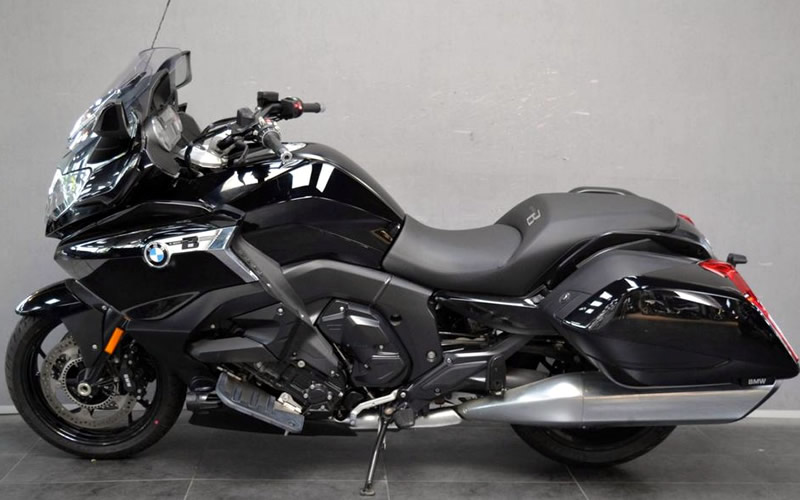
K 1600 B, 2019 year, left view
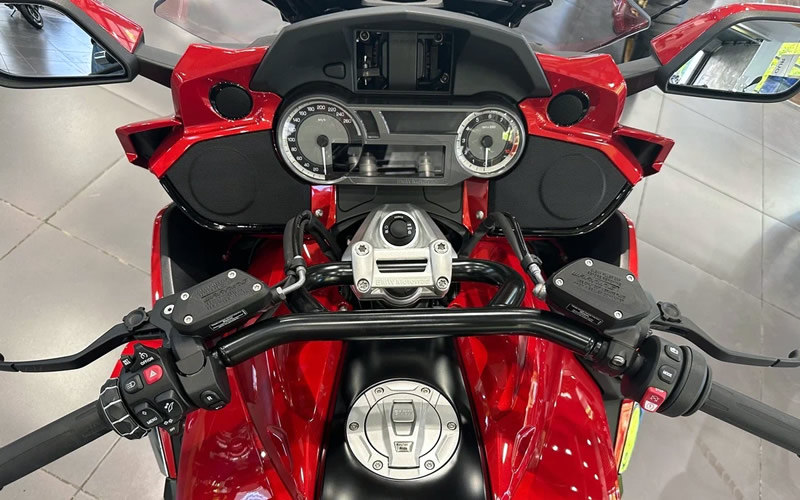
K 1600 B, 2021 year, dashboard
Technical data 1600 series
| K1600GT | K1600GTL | |
| Period | 2011- | 2011- |
| Category | touring motorcycle | |
| Engine type | liquid-cooled six-cylinder - DOHC - four-stroke engine | |
| Construction method | transversely mounted inline engine | |
| Bore | 72 mm | |
| Stroke | 67.5 mm | |
| Cylinder capacity | 1,649 cc | |
| Max. power | 118 kW/160.5 hp at 7,750 rpm | |
| Max. torque | 175 Nm at 5,250 rpm | |
| Top speed | approx. 260 km/h | |
| Drive | cardan drive | |
| Bicycle part | aluminum bridge frame magnesium subframe front aluminum rear frame | |
| Curb weight | 319 kg | 348 kg |
| Tank capacity | 24 liter | 26.5 liters |
| Predecessor | K1300GT | K1200LT Edition |
| Competitors | Honda ST1300 Pan European Kawasaki GTR1400 Yamaha FJR1300 | Honda GL1800 GoldWing |
- Information for owner
- Introduction to manual
- Weekly checks
- Maintenance
- Engine and systems
- Engine repair
- Starting and charging system
- Fuel and exhaust systems
- Cooling system
- Transmission
- Running gear and frame
- Frame and hinged elements
- Front suspension and fork
- Rear wheel drive
- Handlebar
- Brake system
- Wheels and tires
- Electric equipment
- Equipment and devices
Aprilia: RS-series Shiver (map) BMW: F-series R-series K-series (map) Ducati: ST series Monster (map) Harley: Street Sportster V-Rod (map) Honda: Africa Twin CB series VTX series (map) Kawasaki: ZX-6R Versys Vulcan (map) Suzuki: DR-Z V-Strom Boulevard (map) Triumph: Rocket Street Triple Tiger (map) Yamaha: Fazer DragStar R1 (map)
